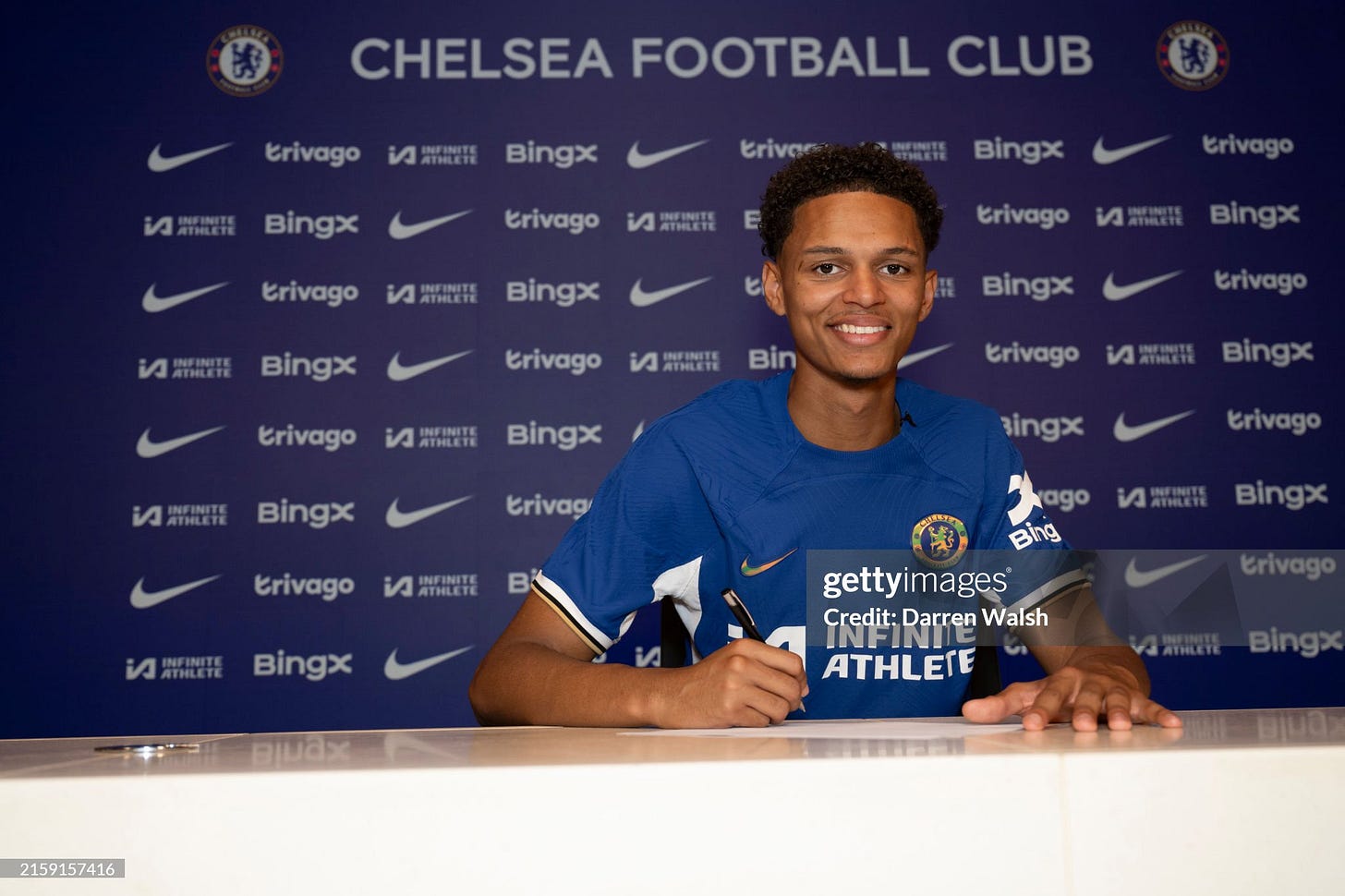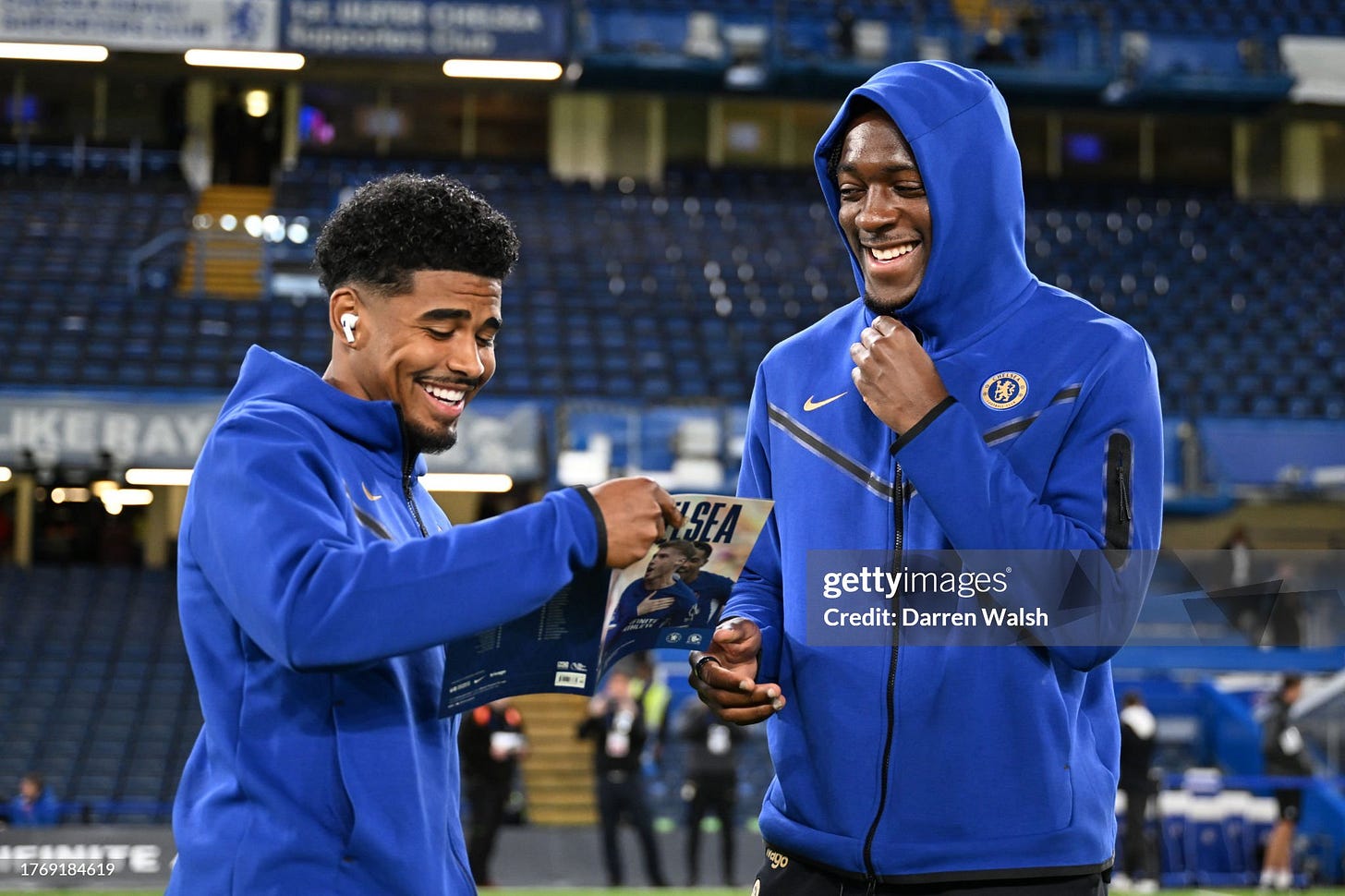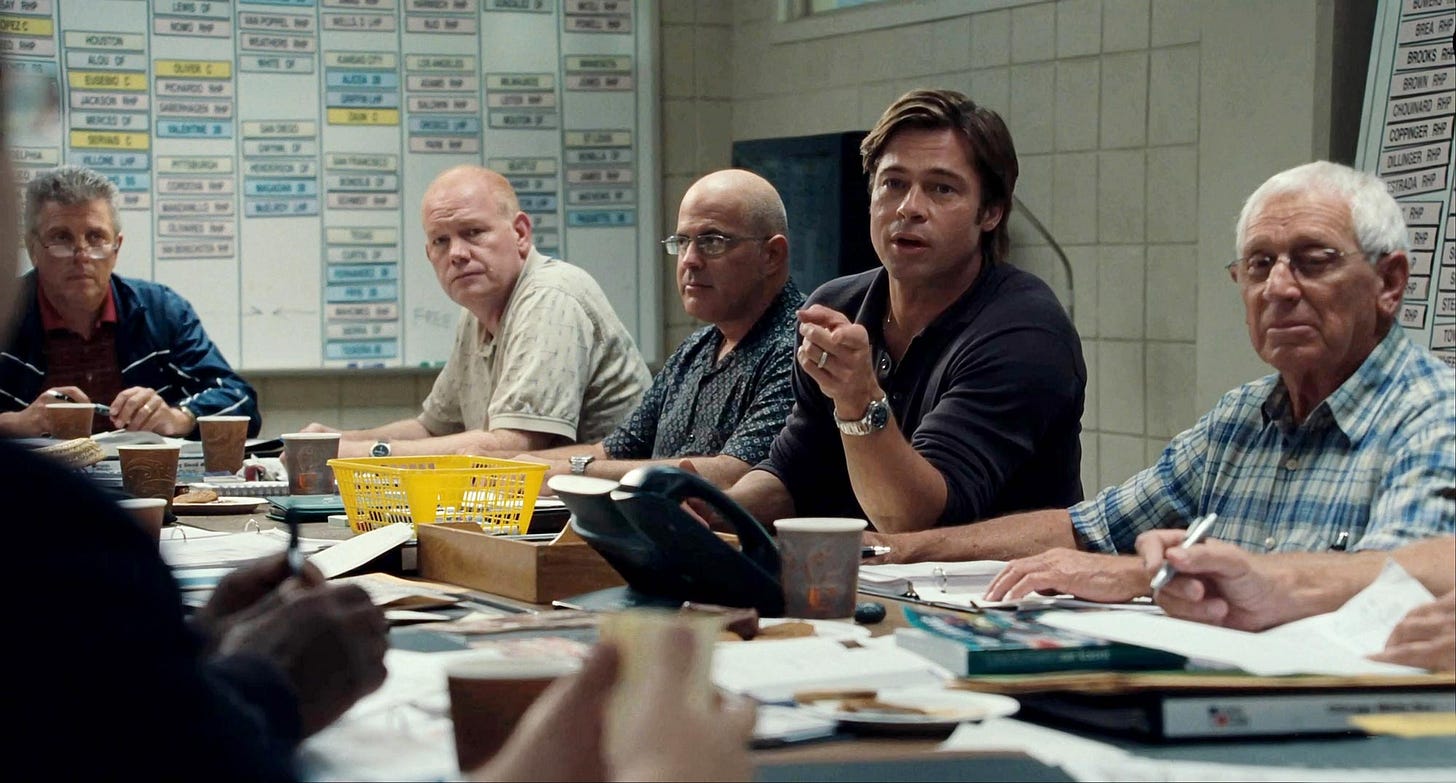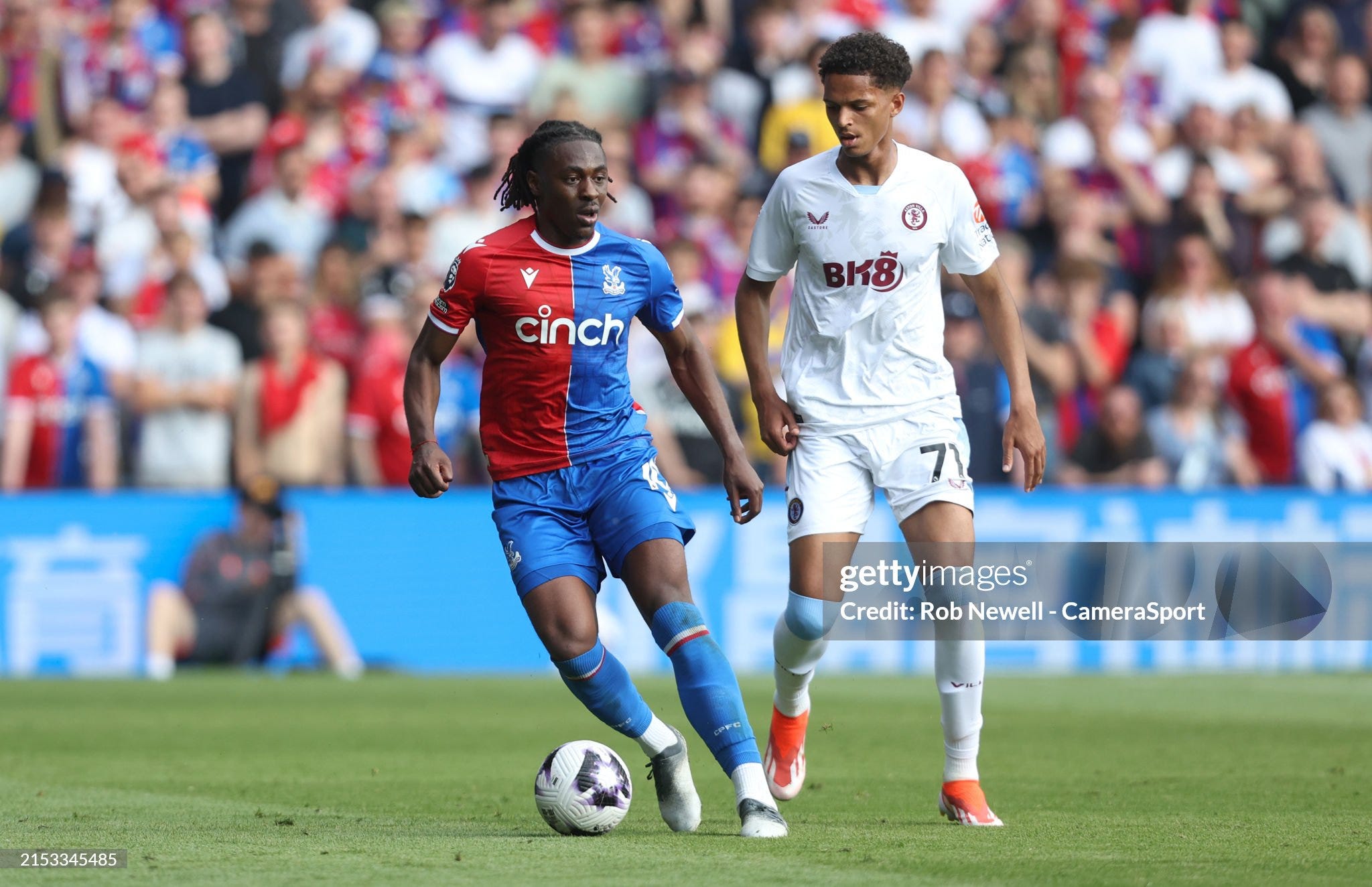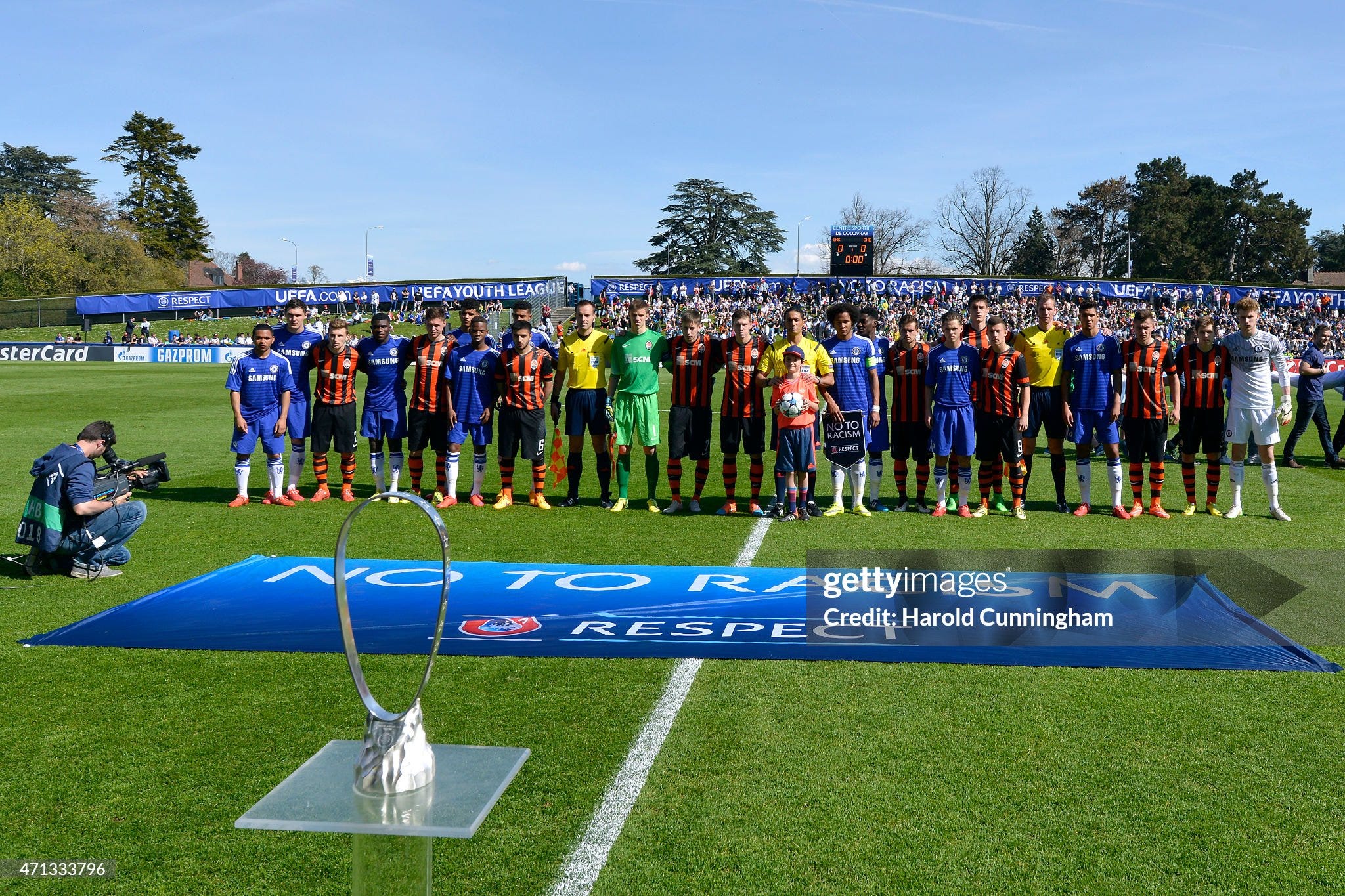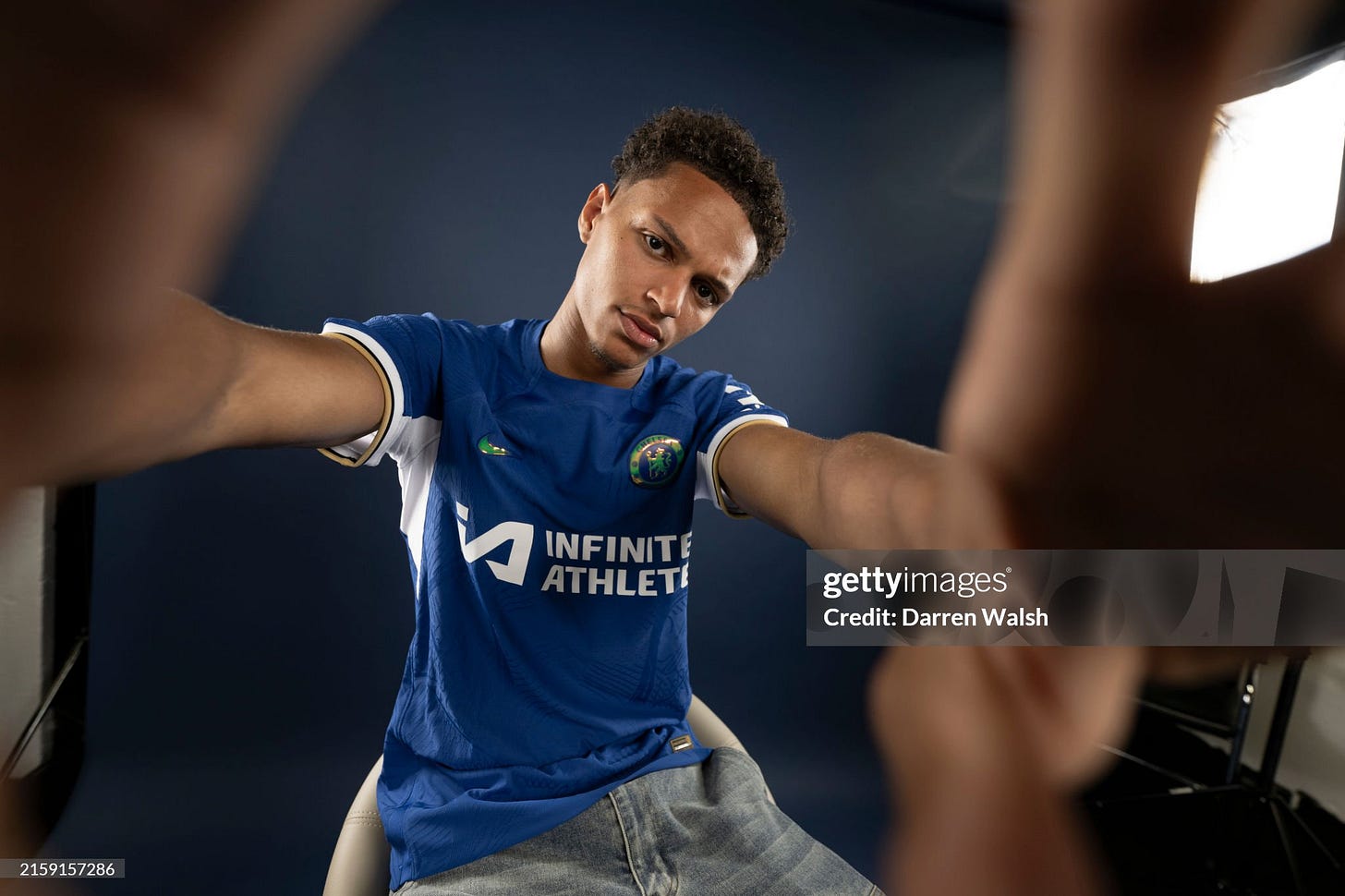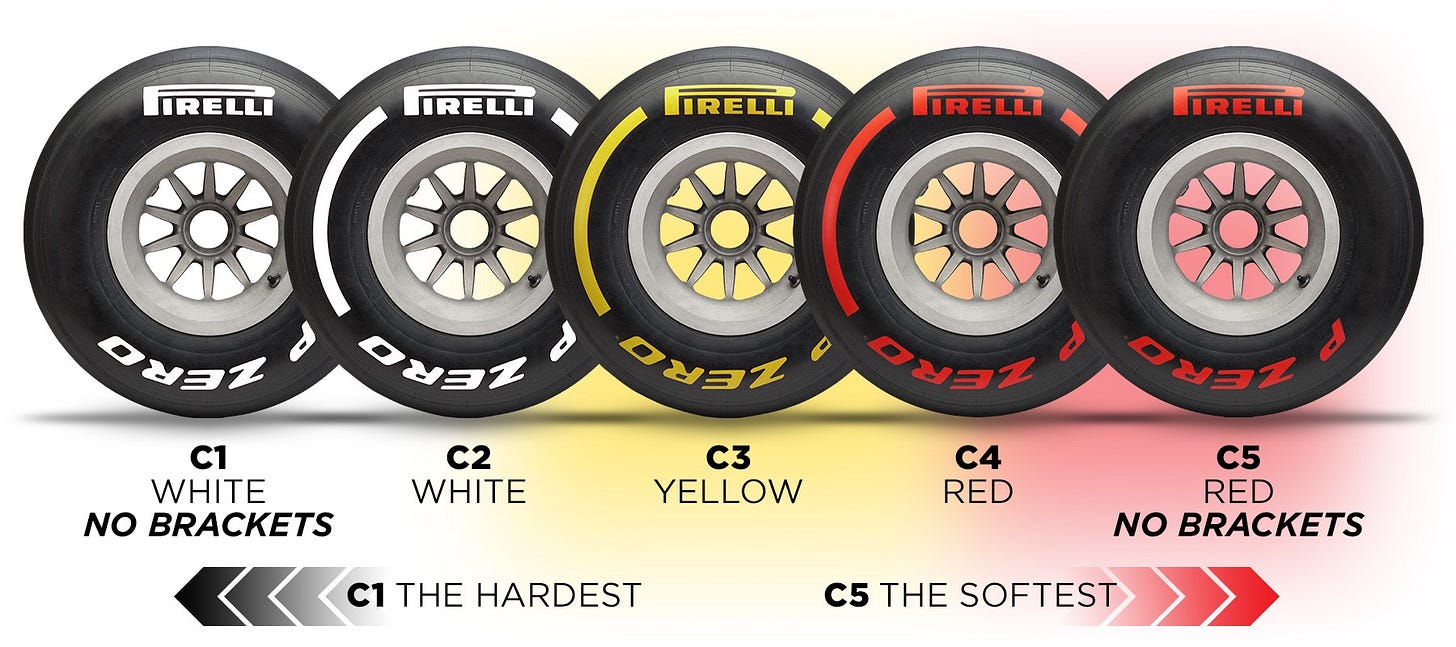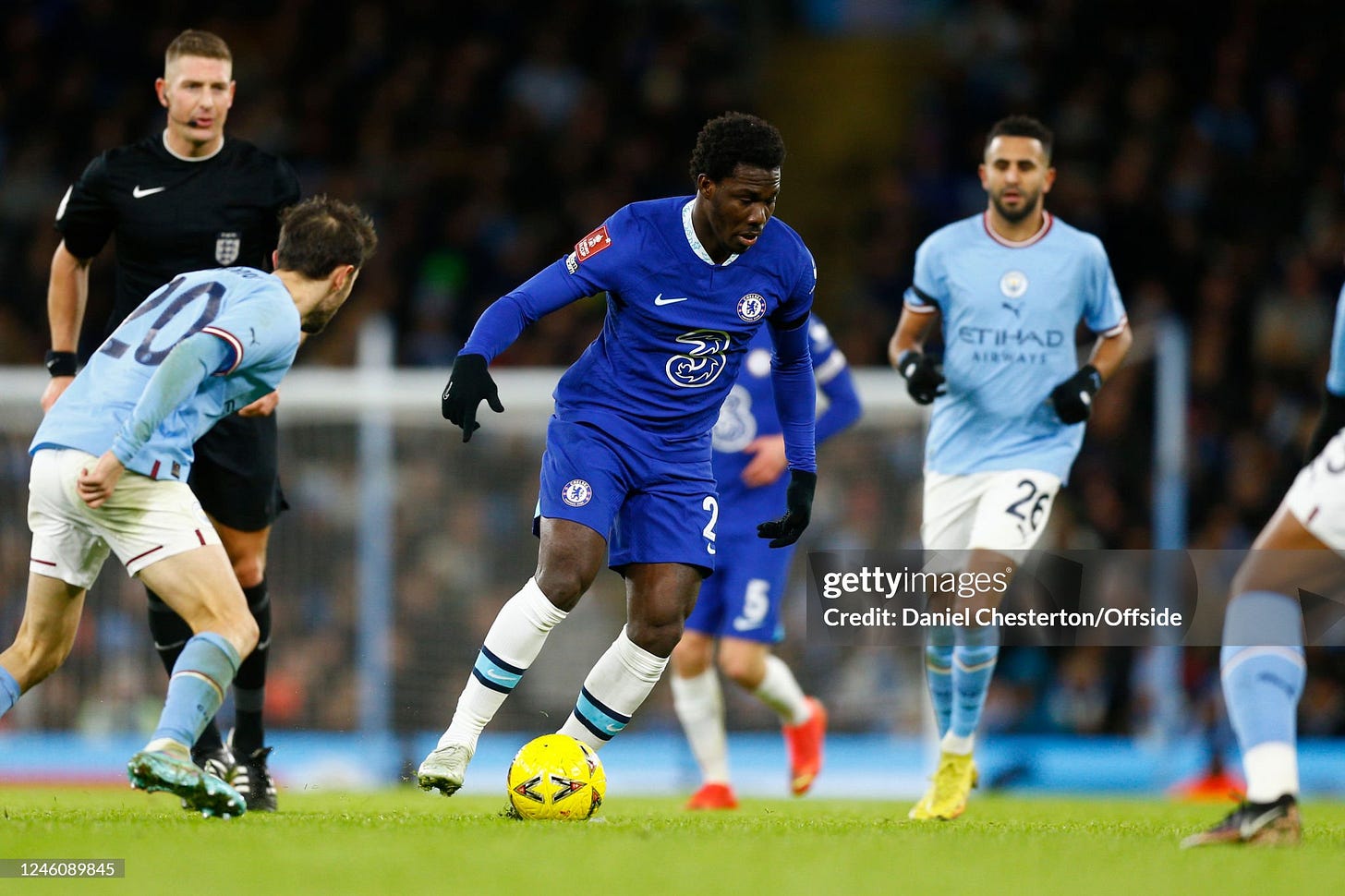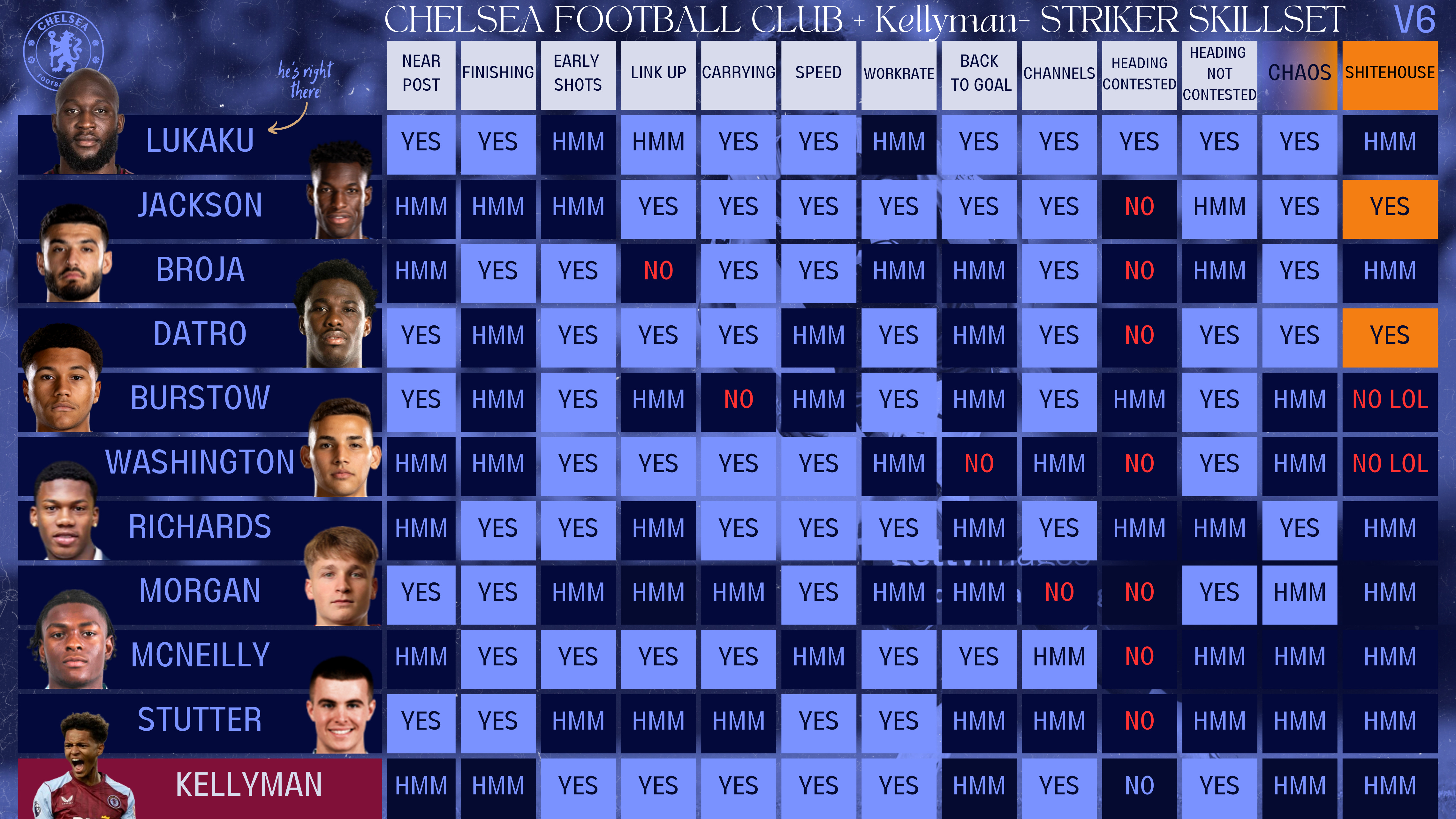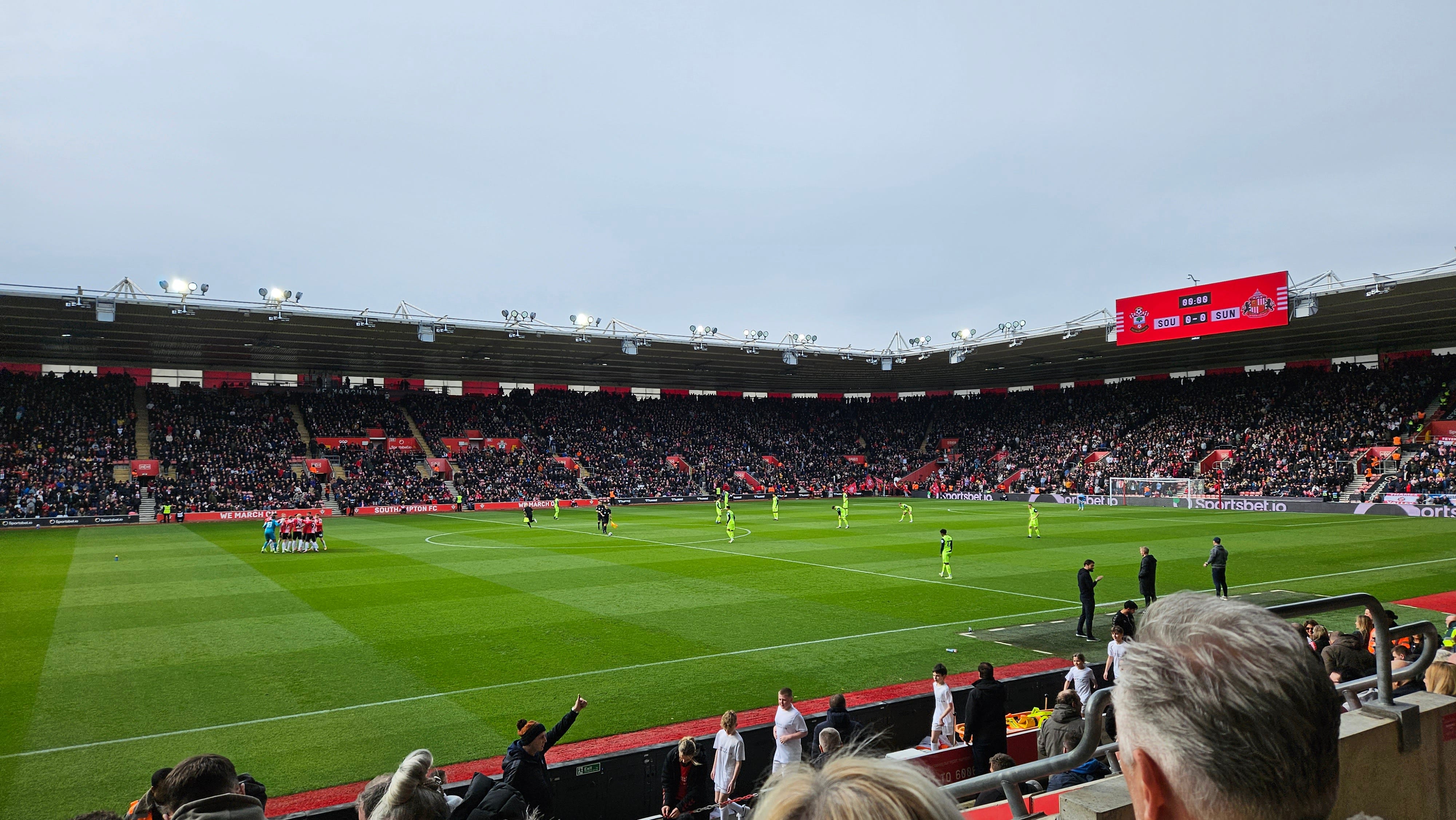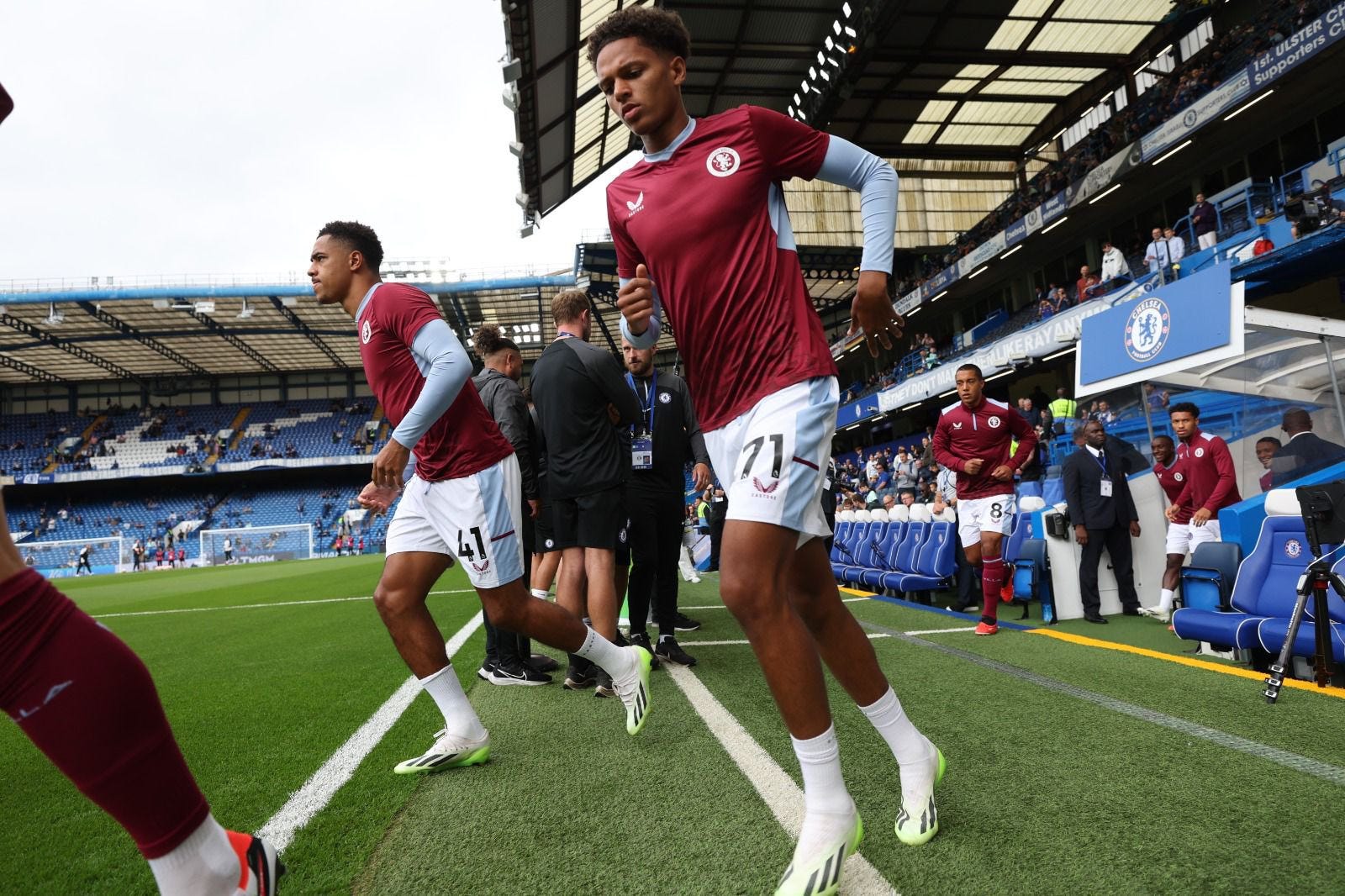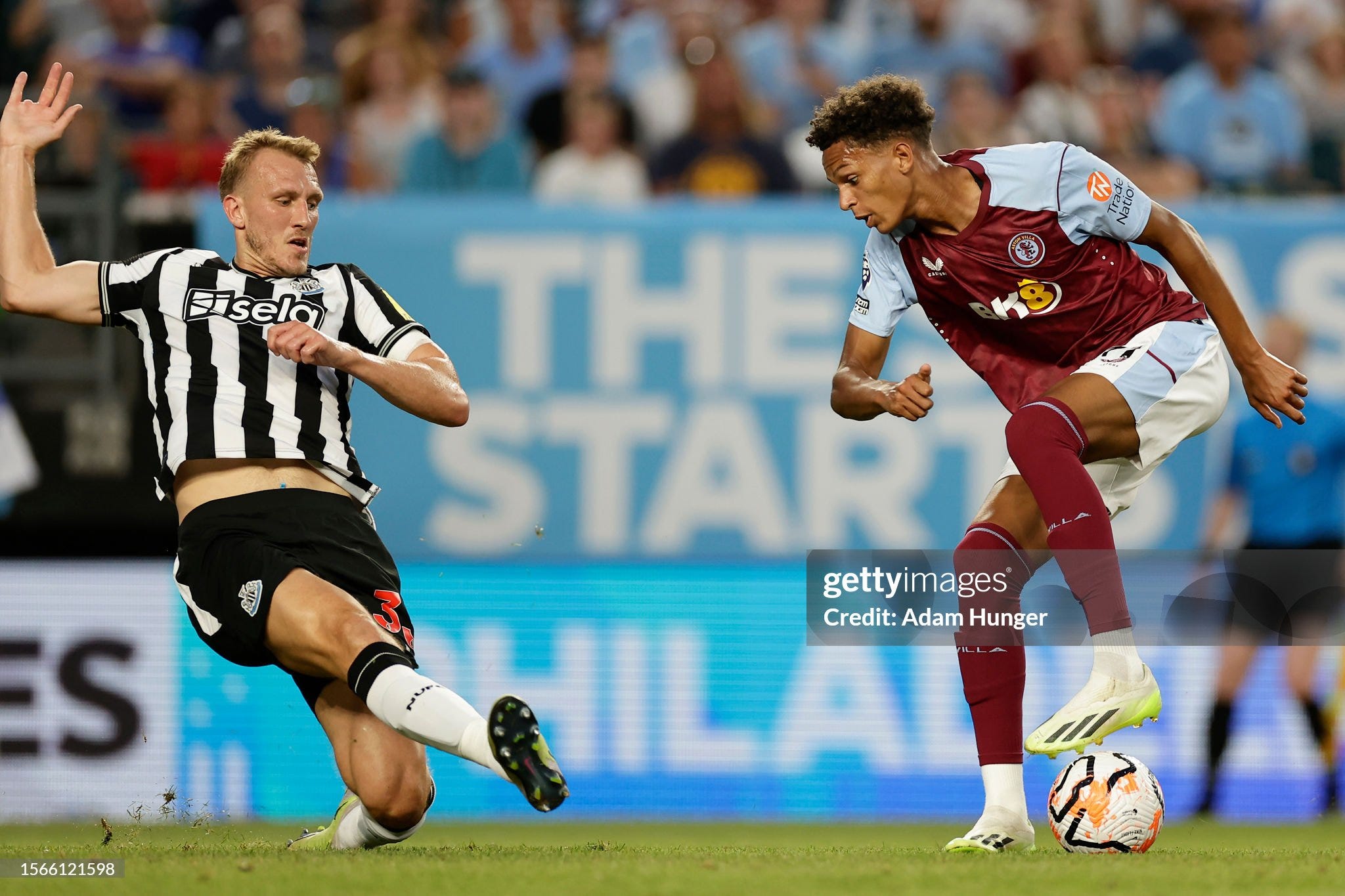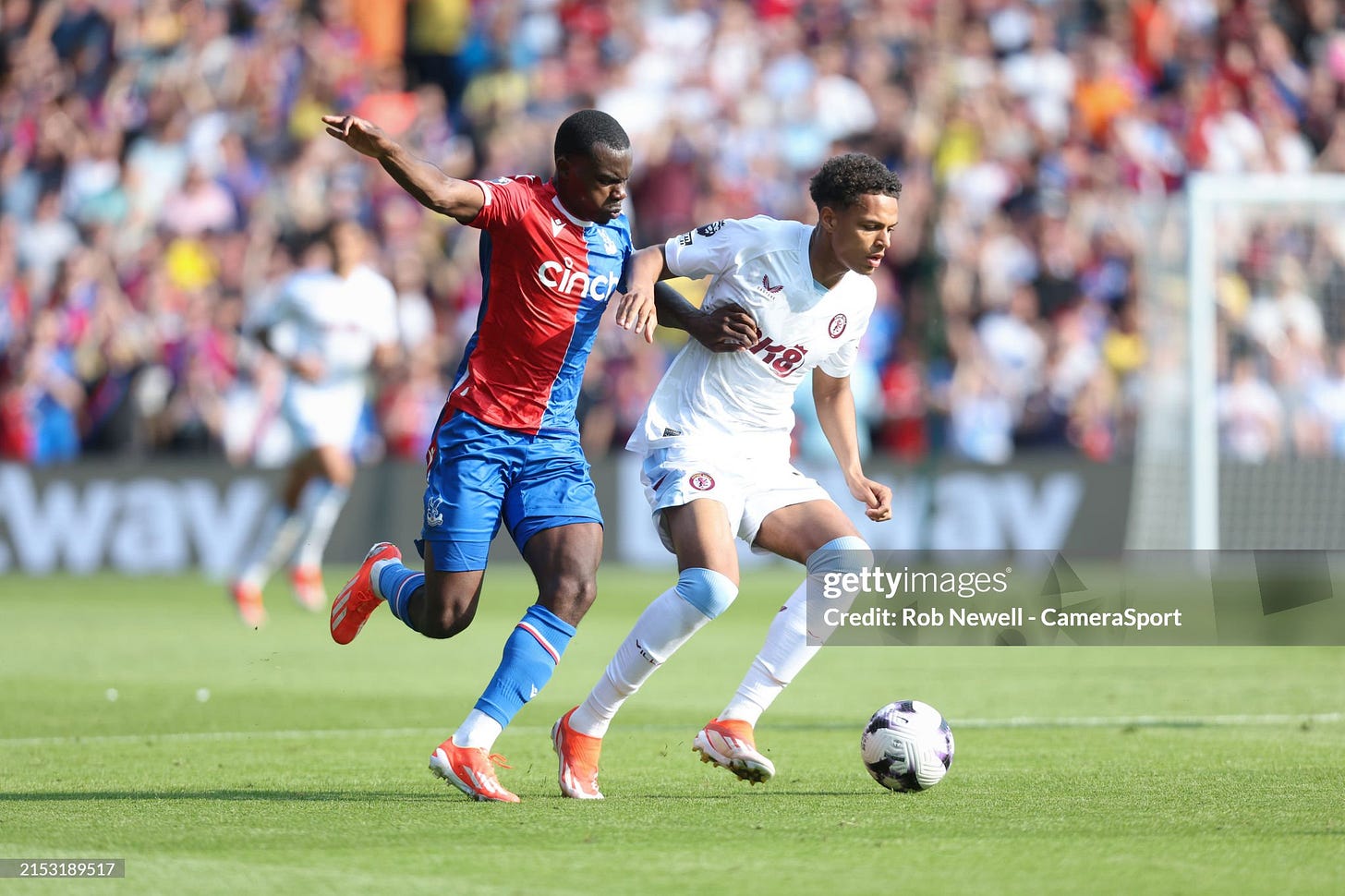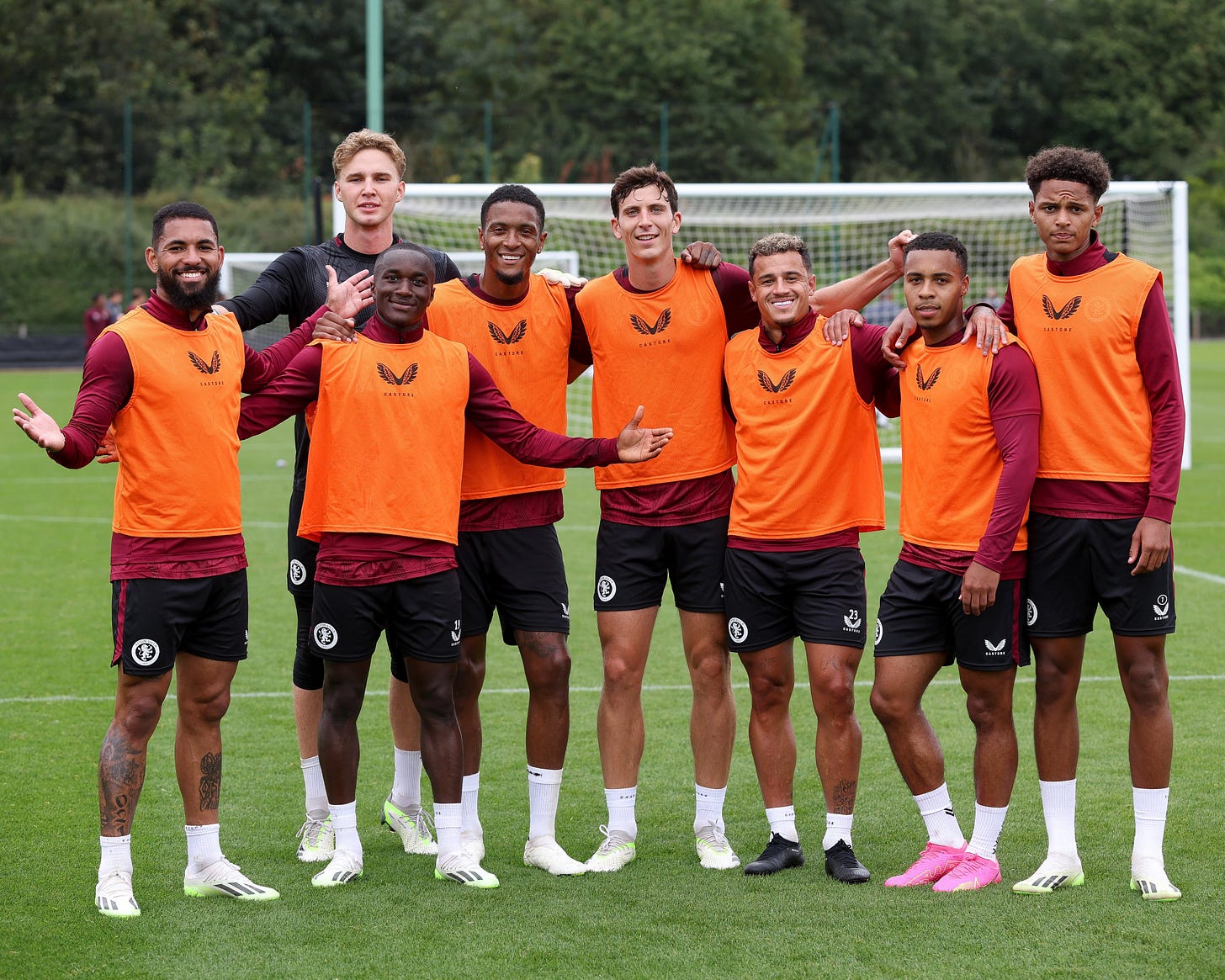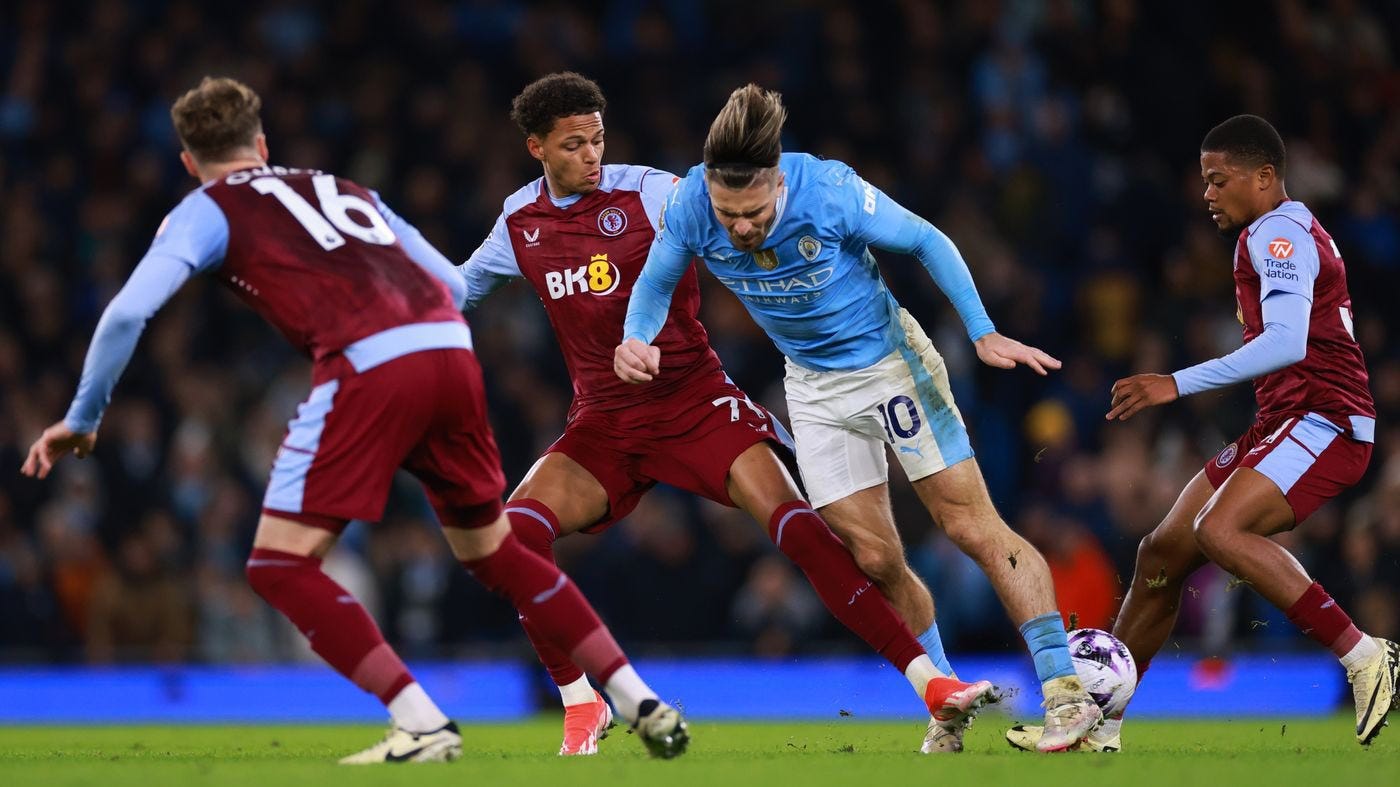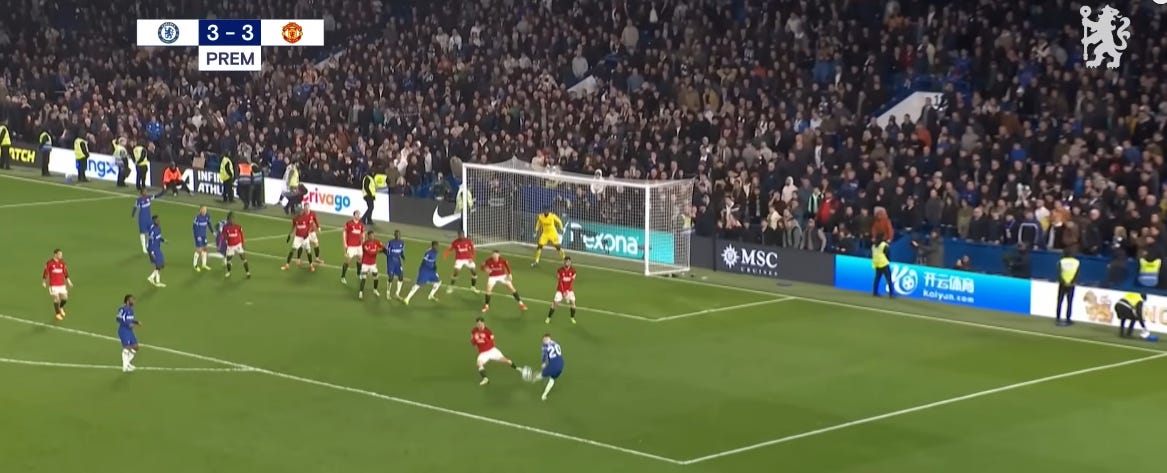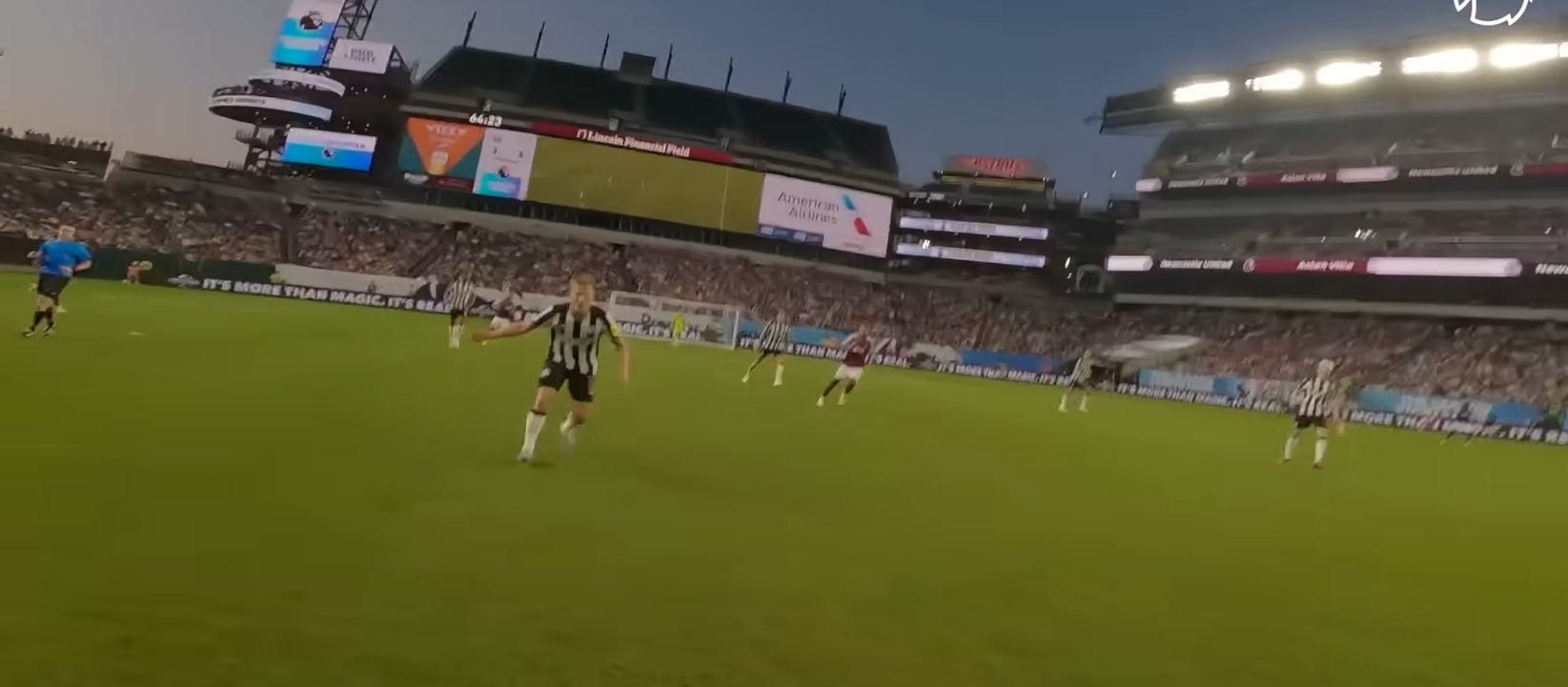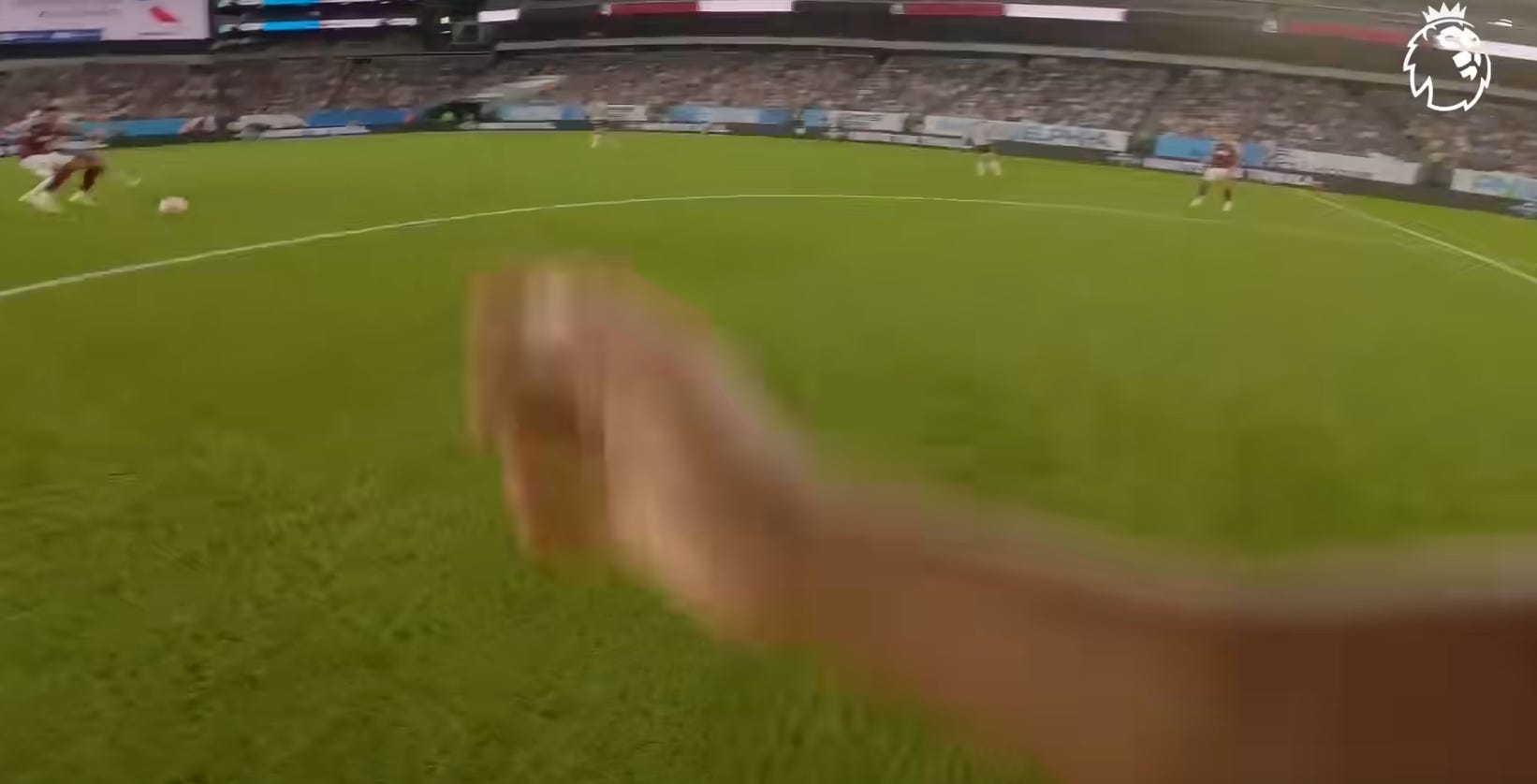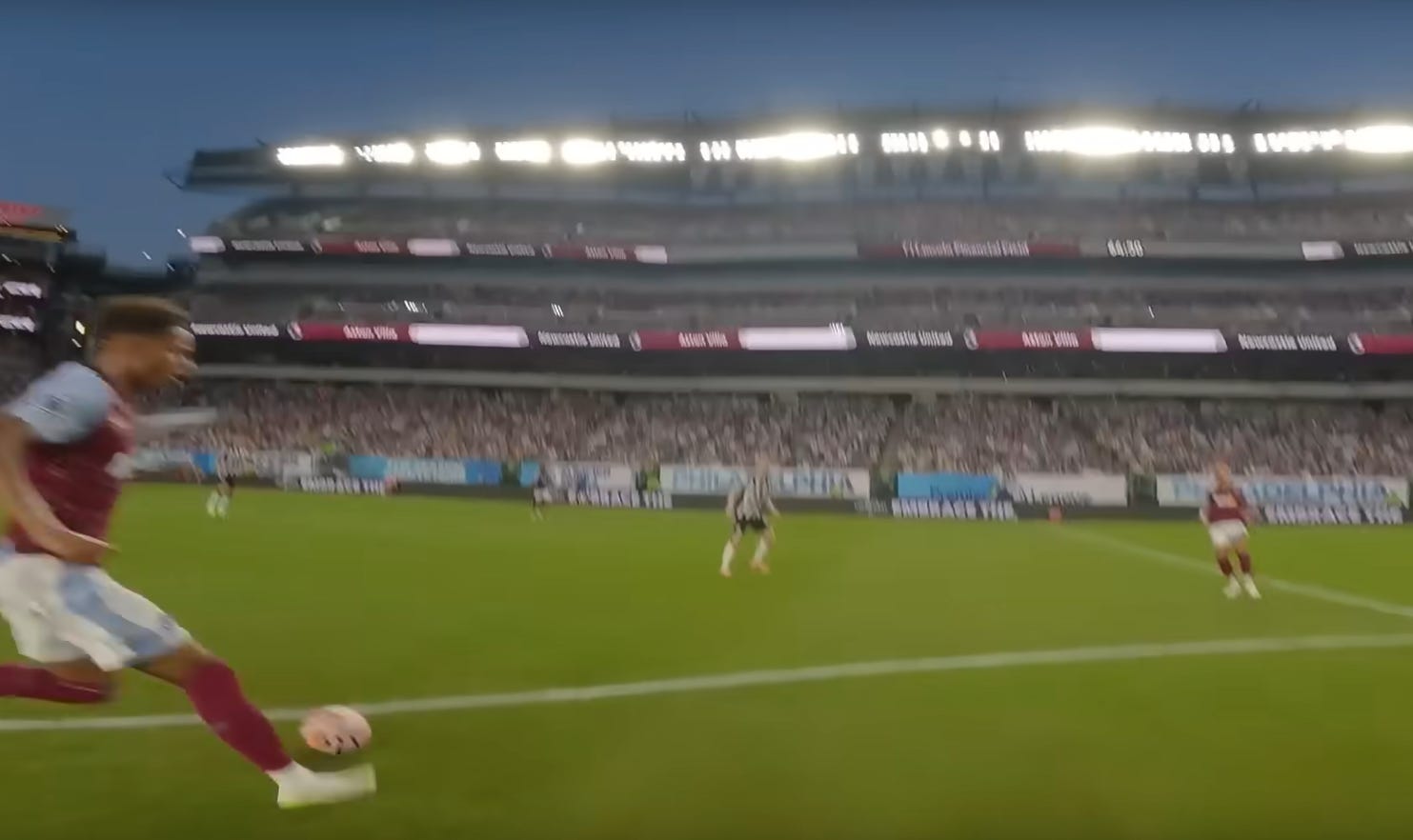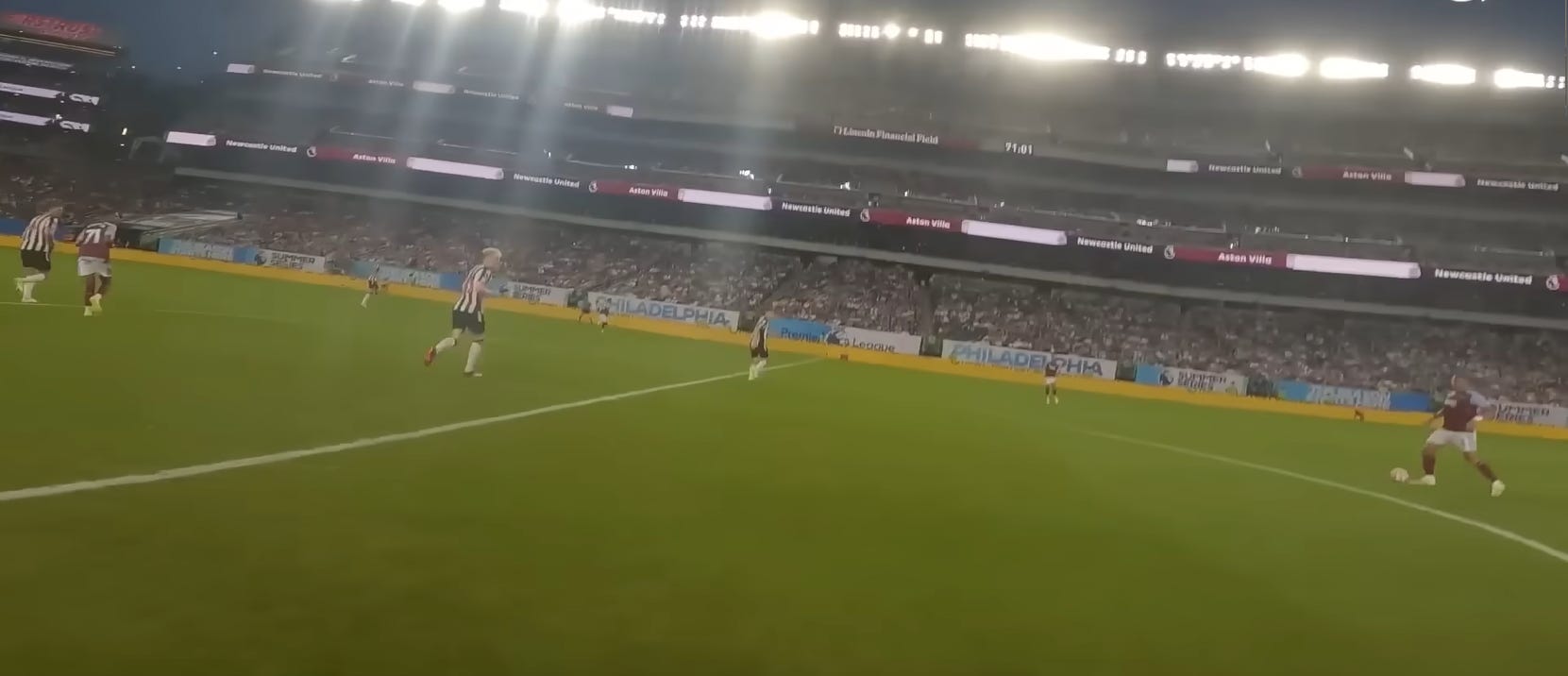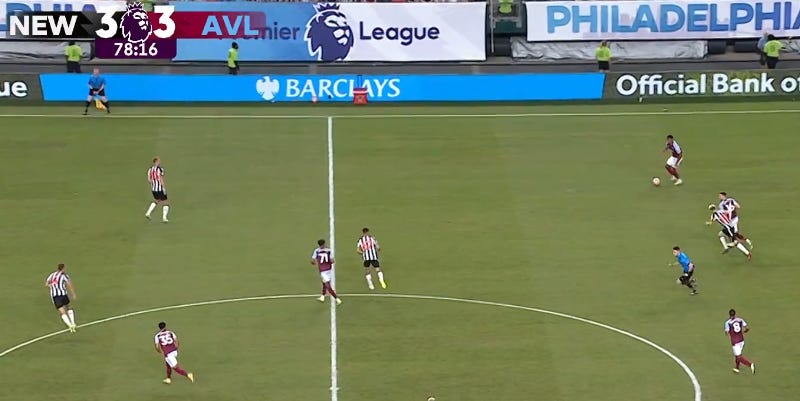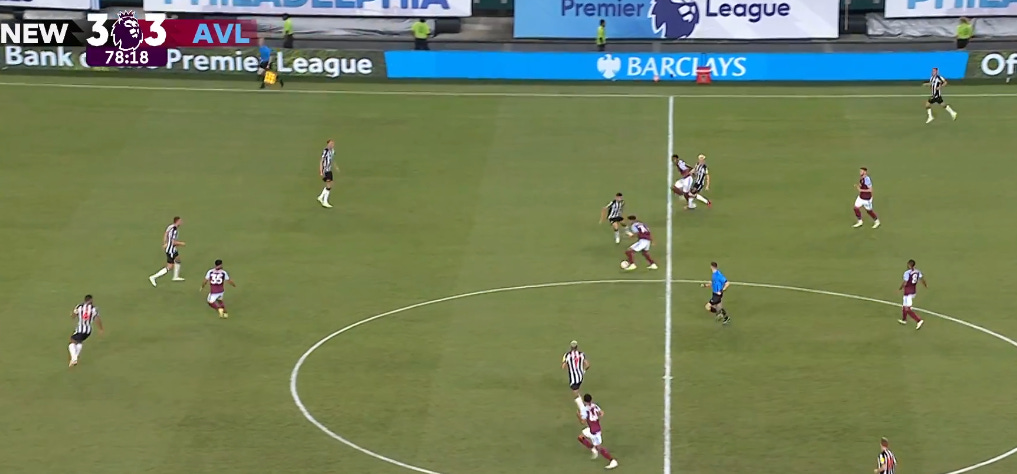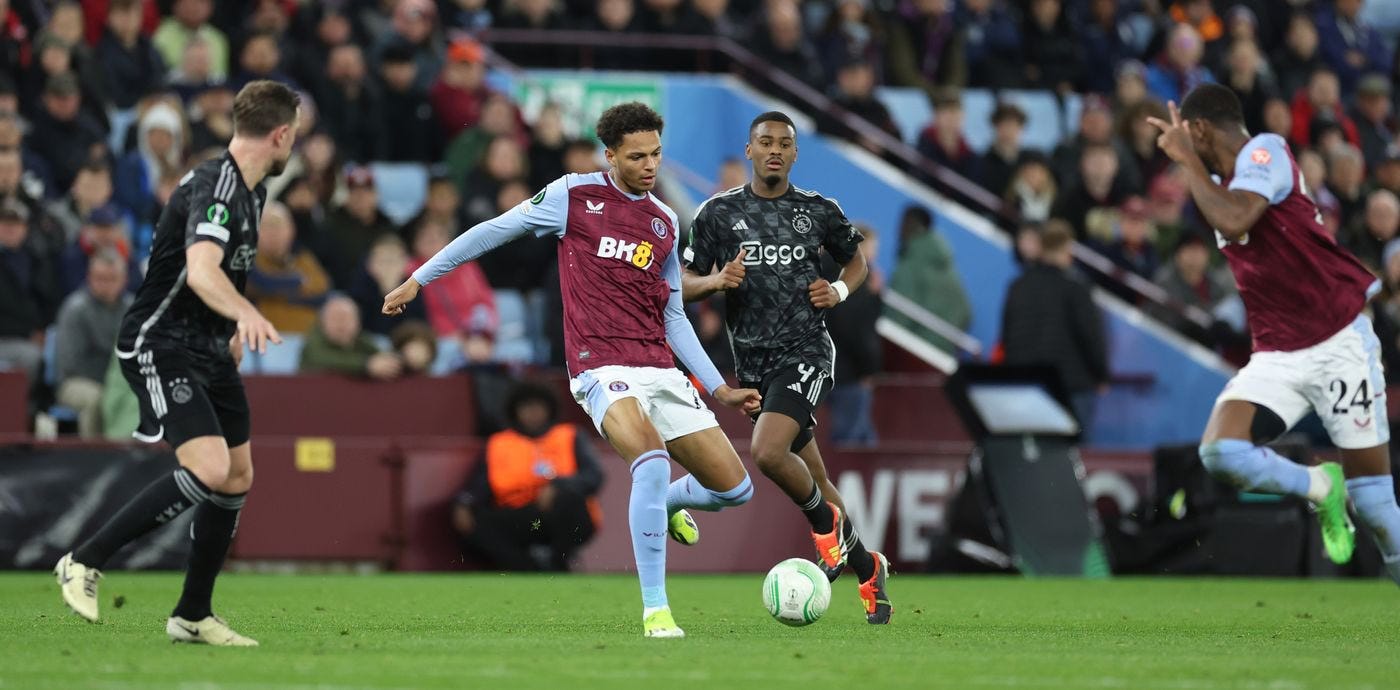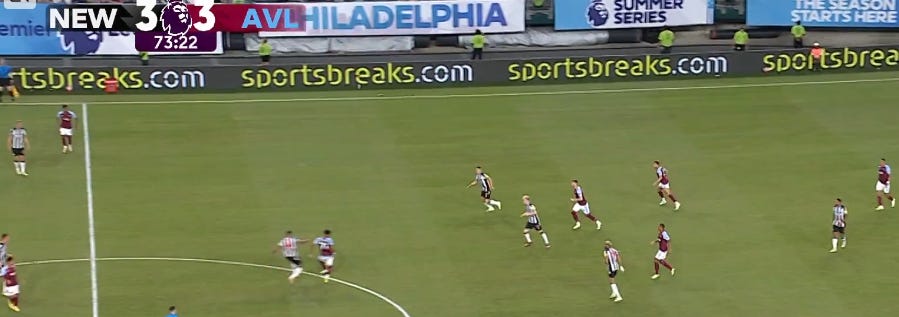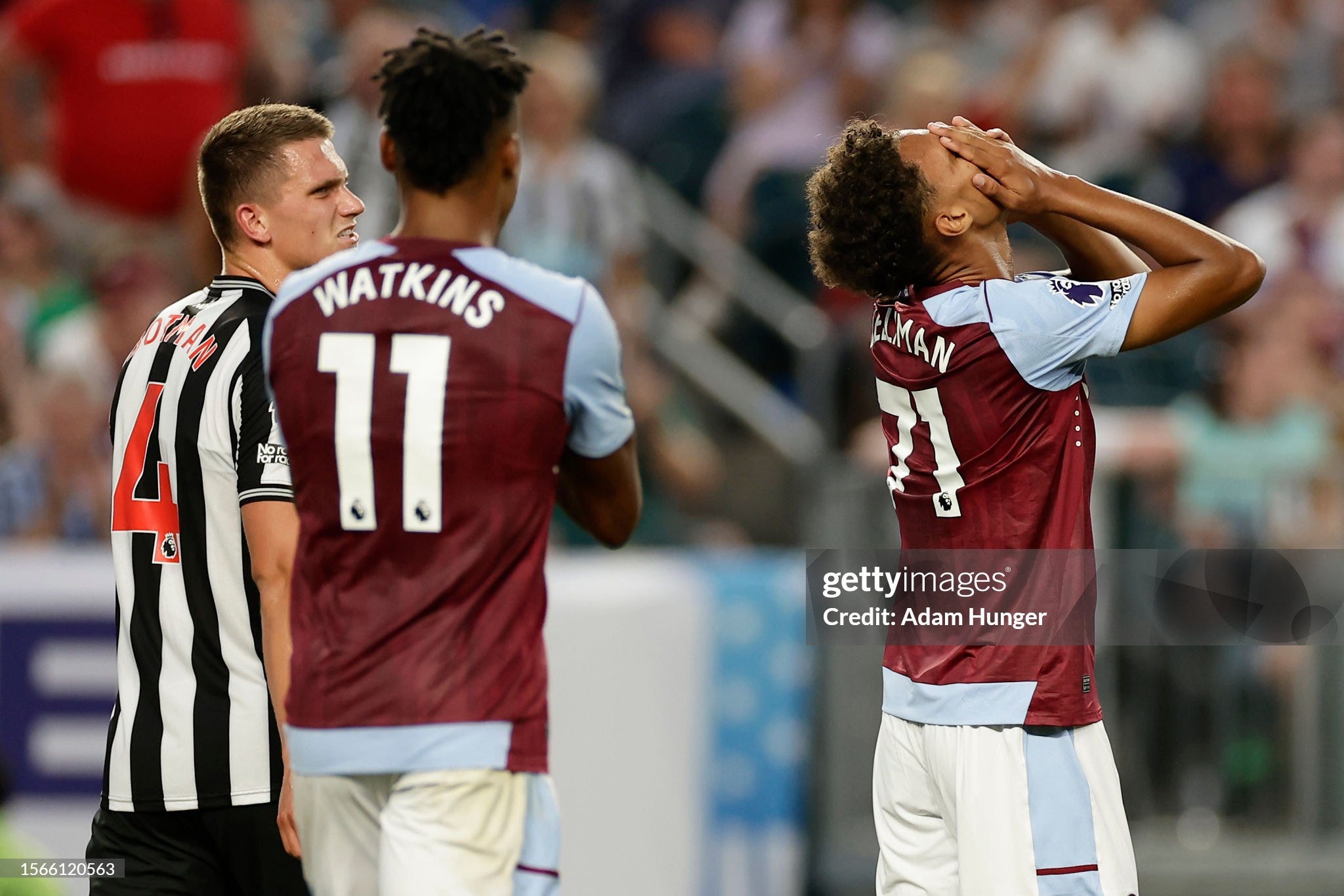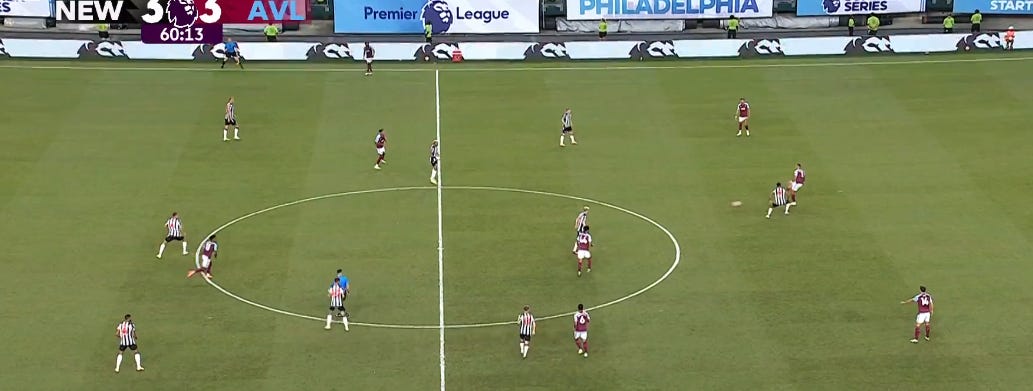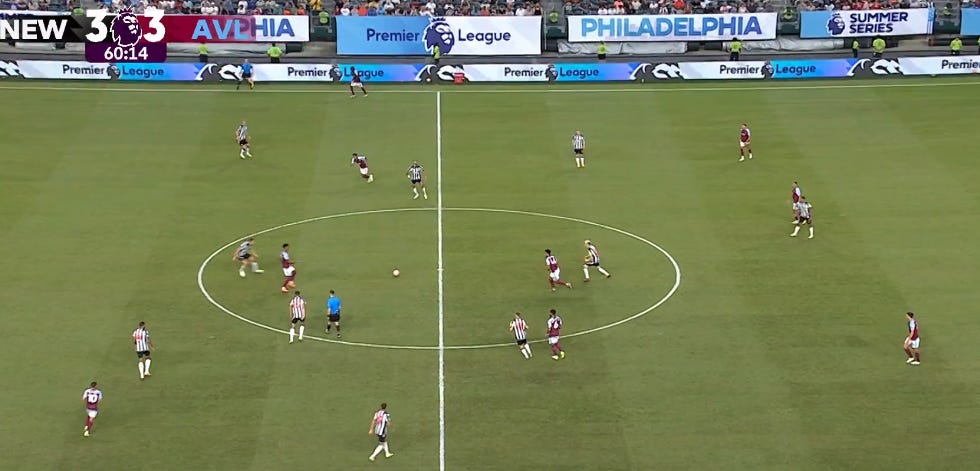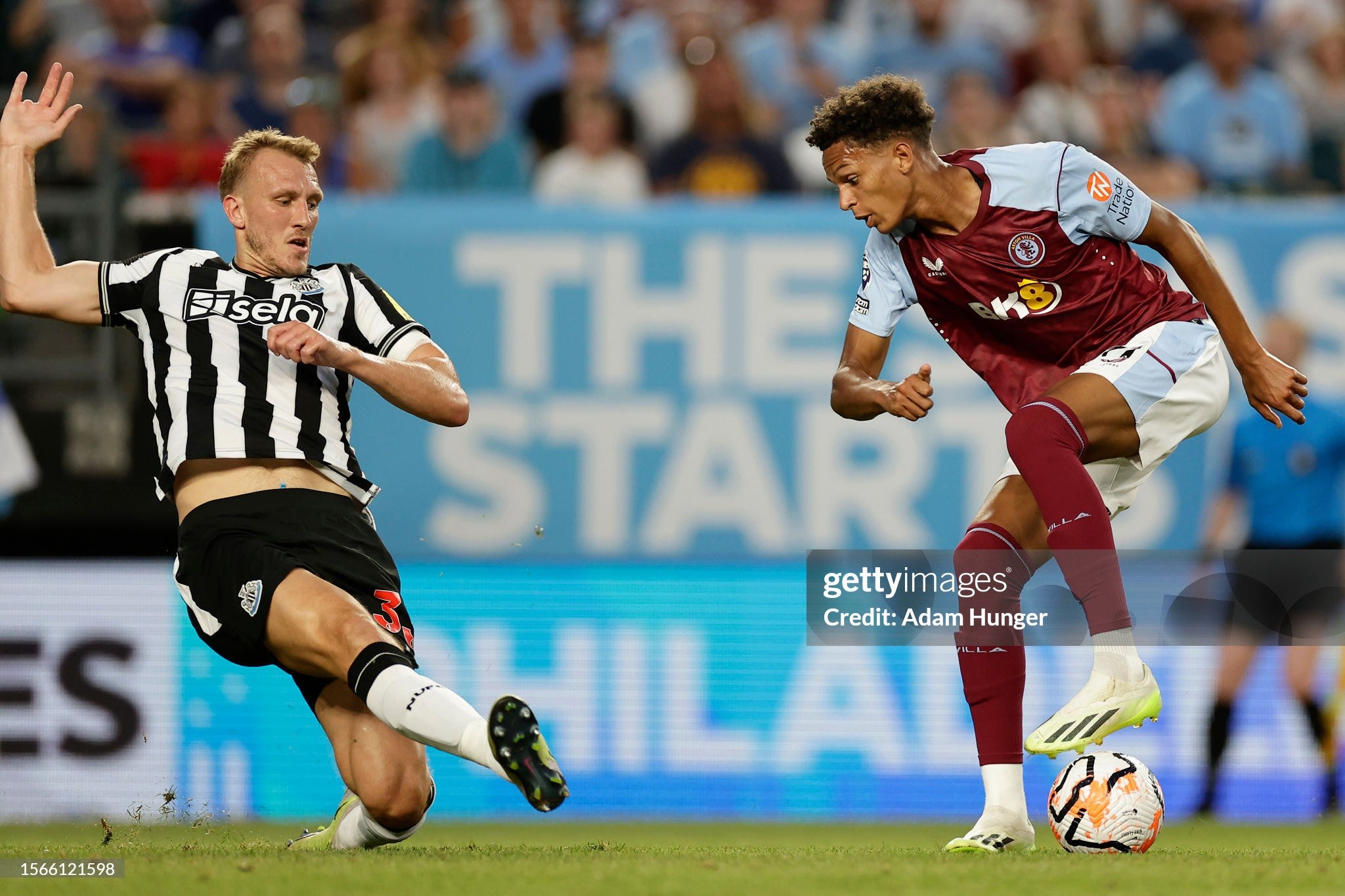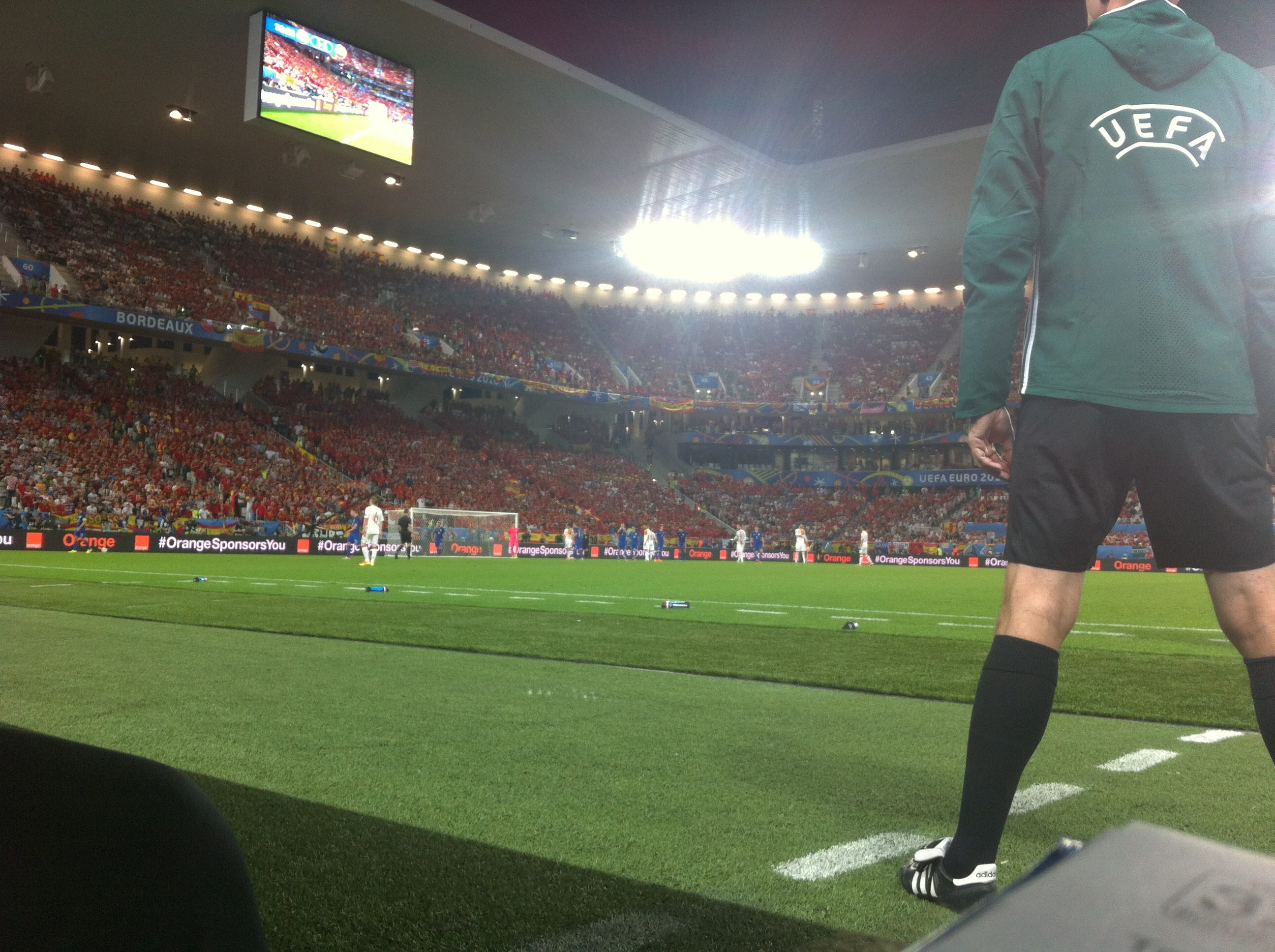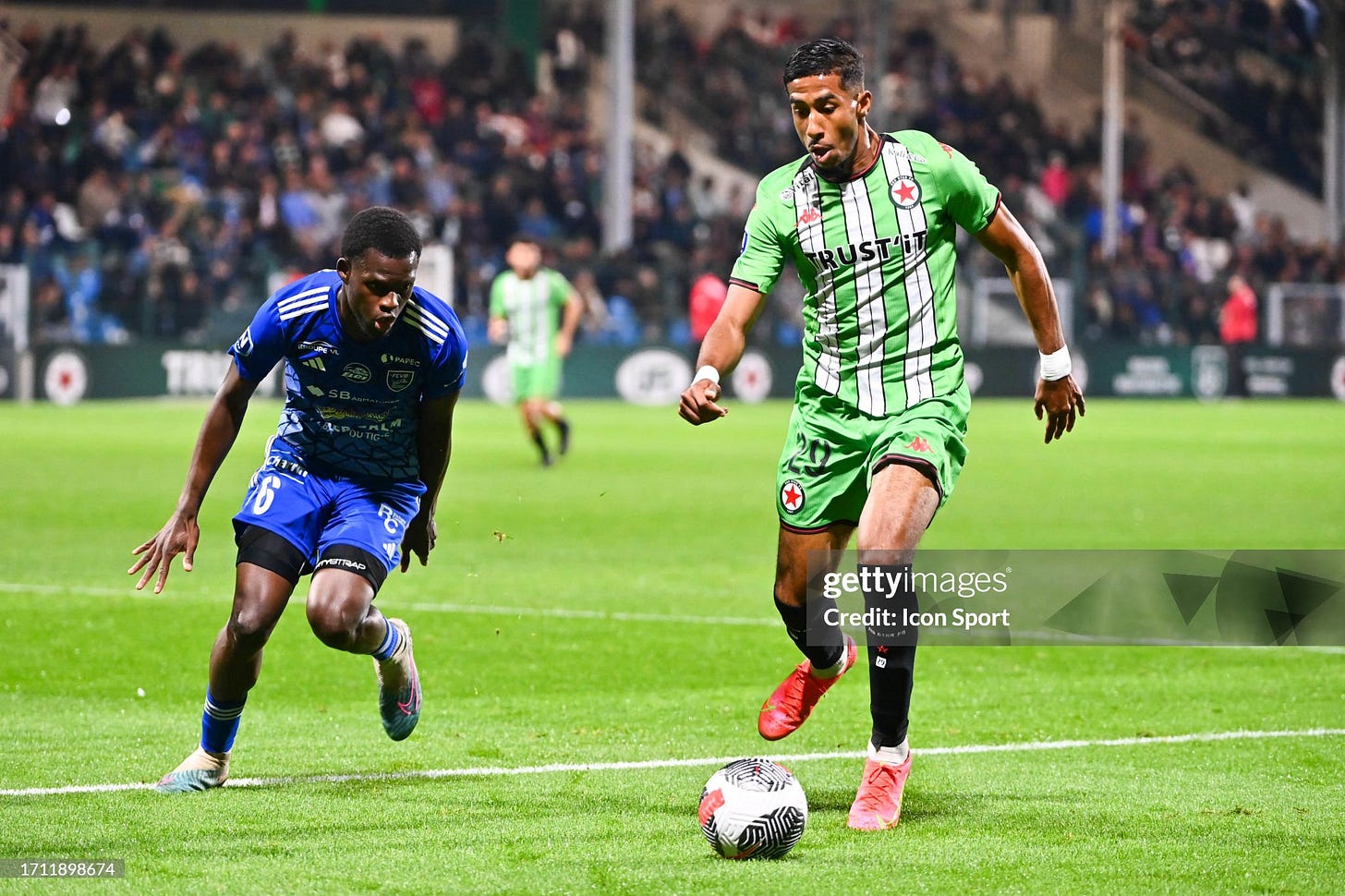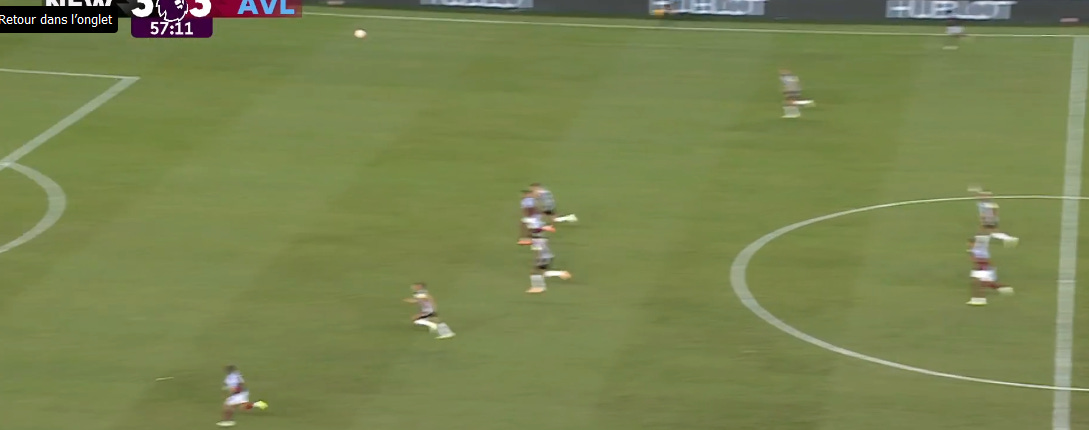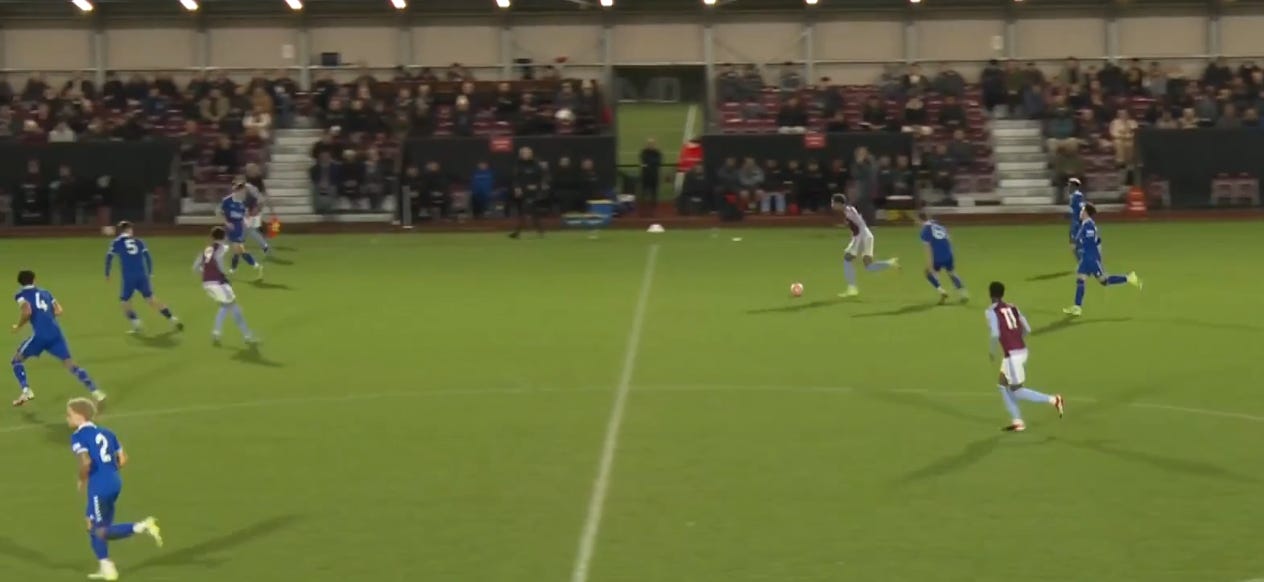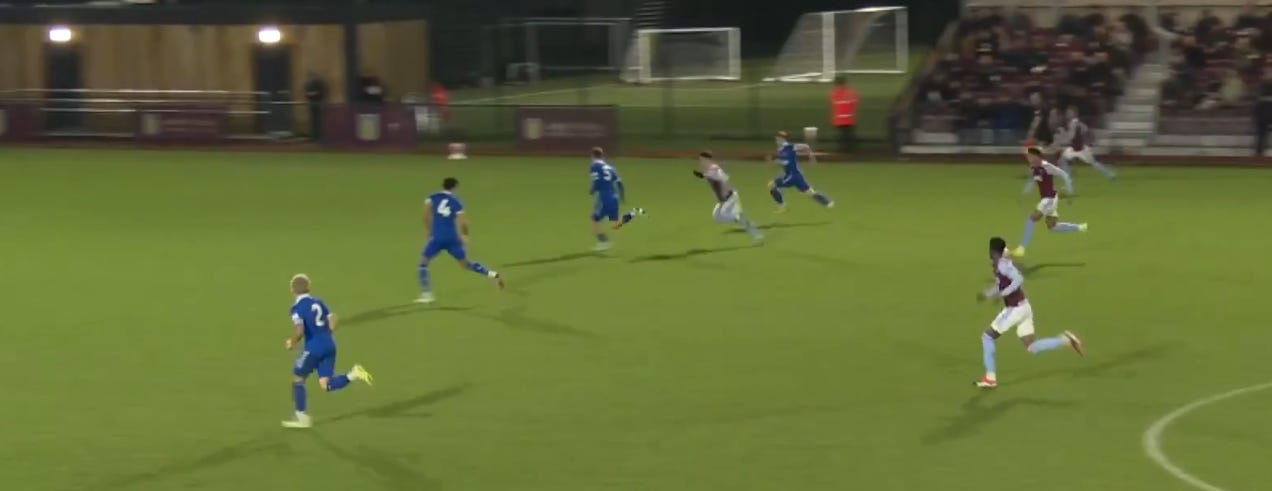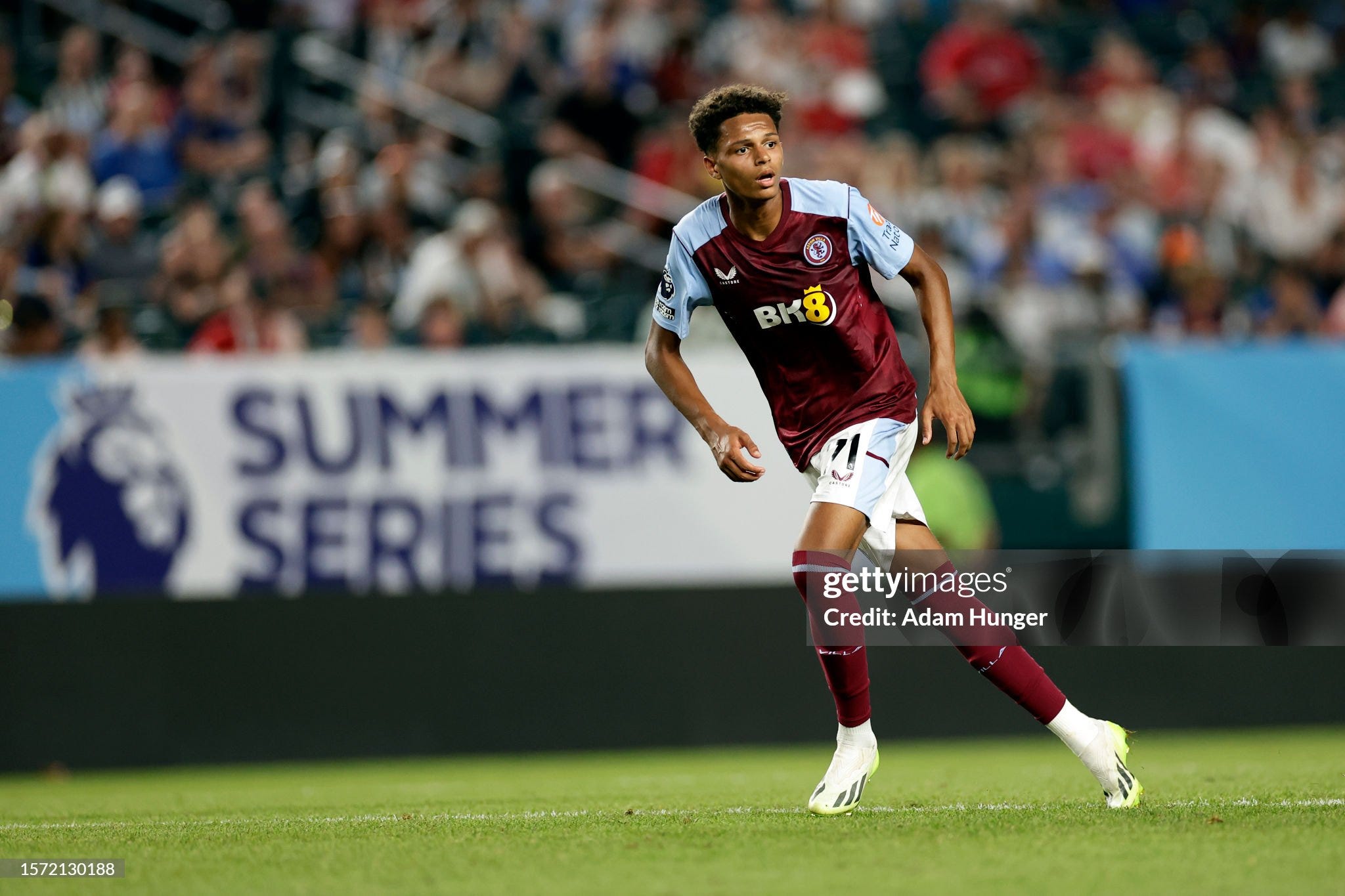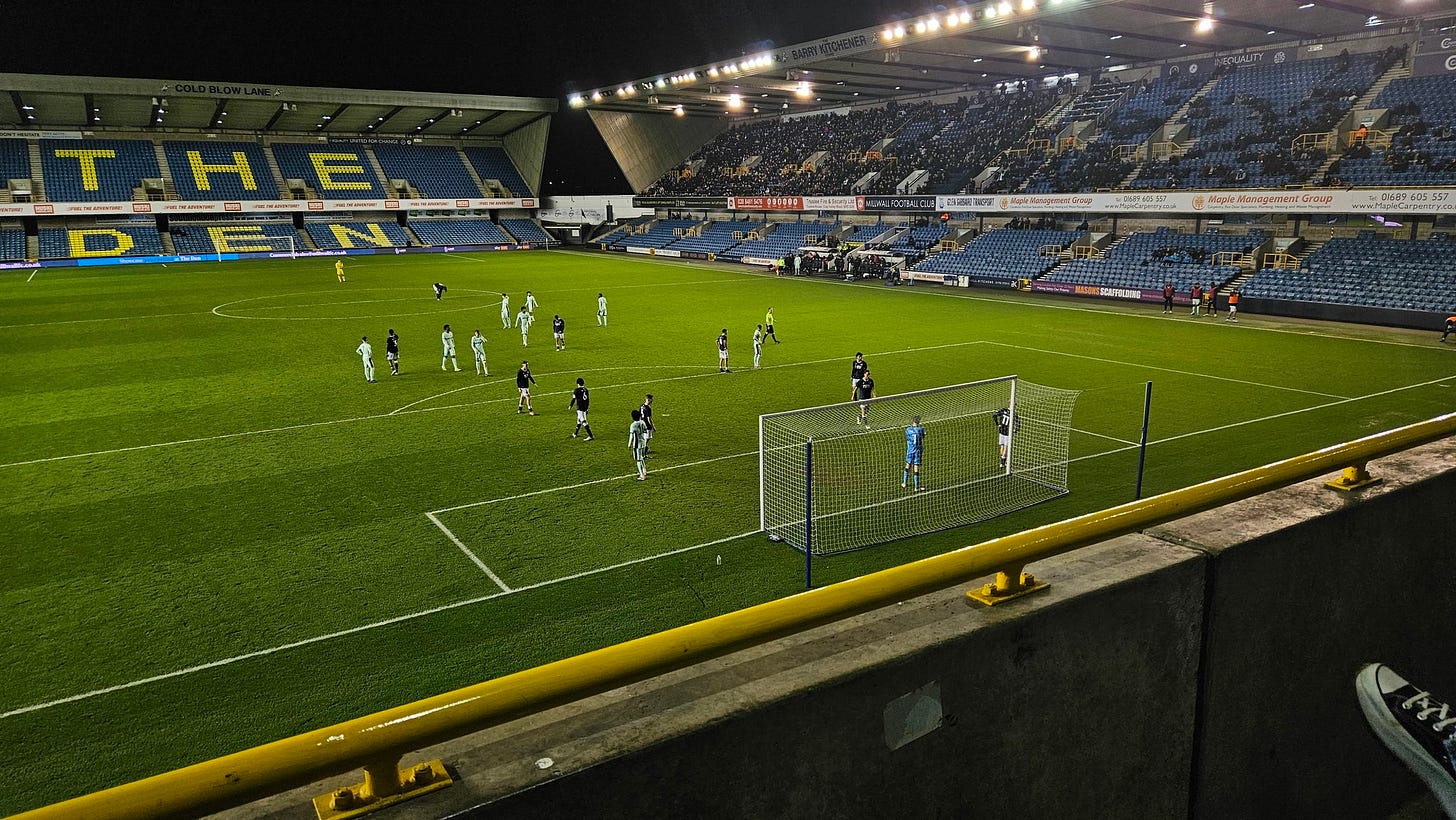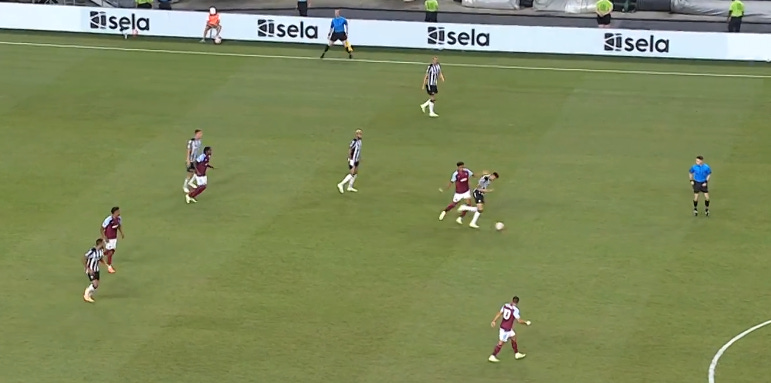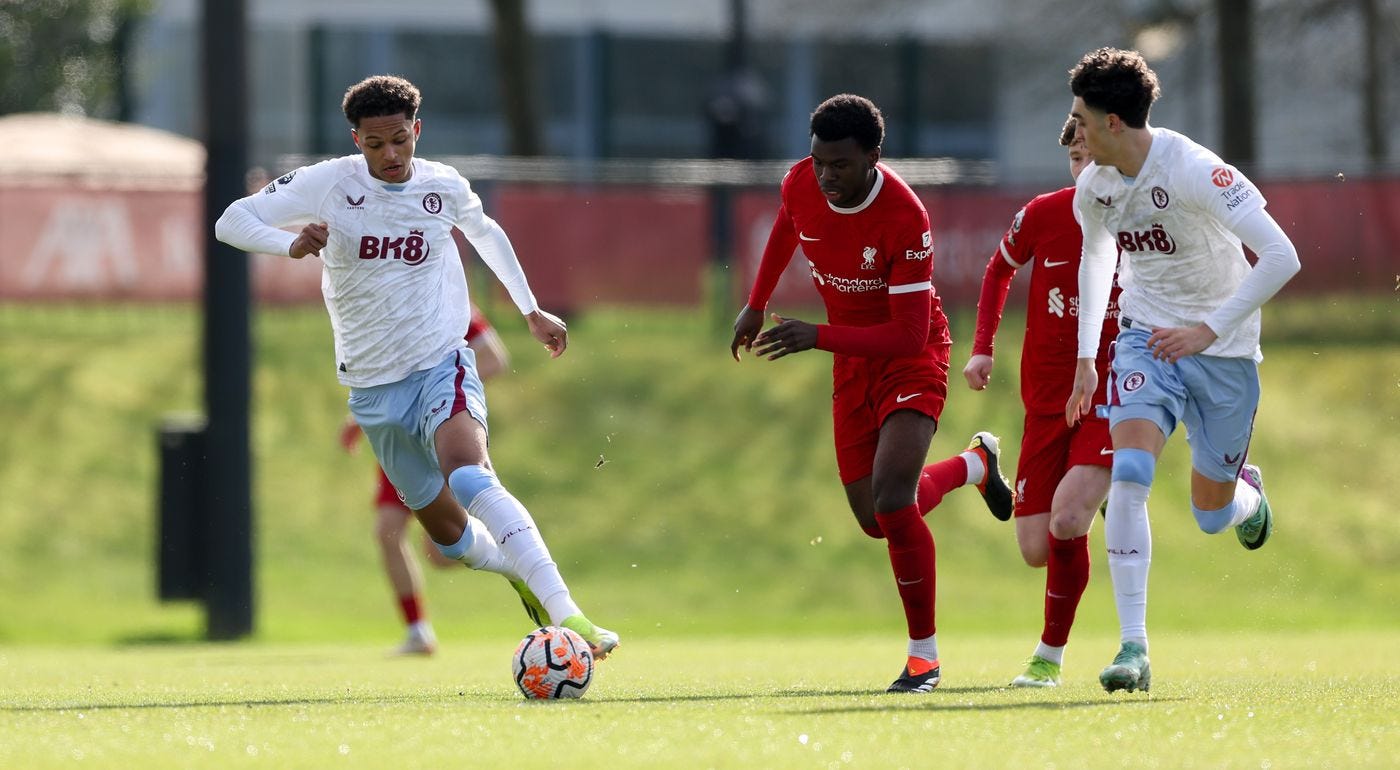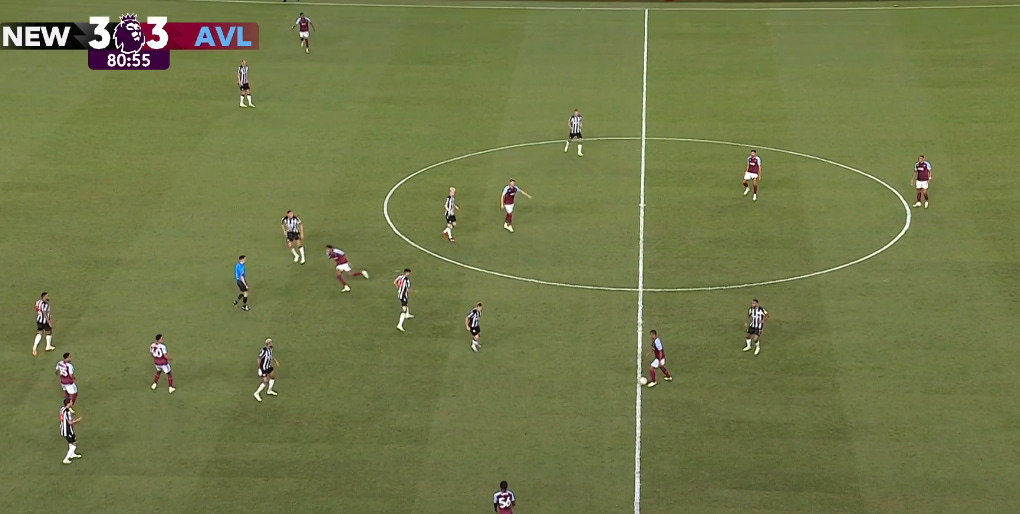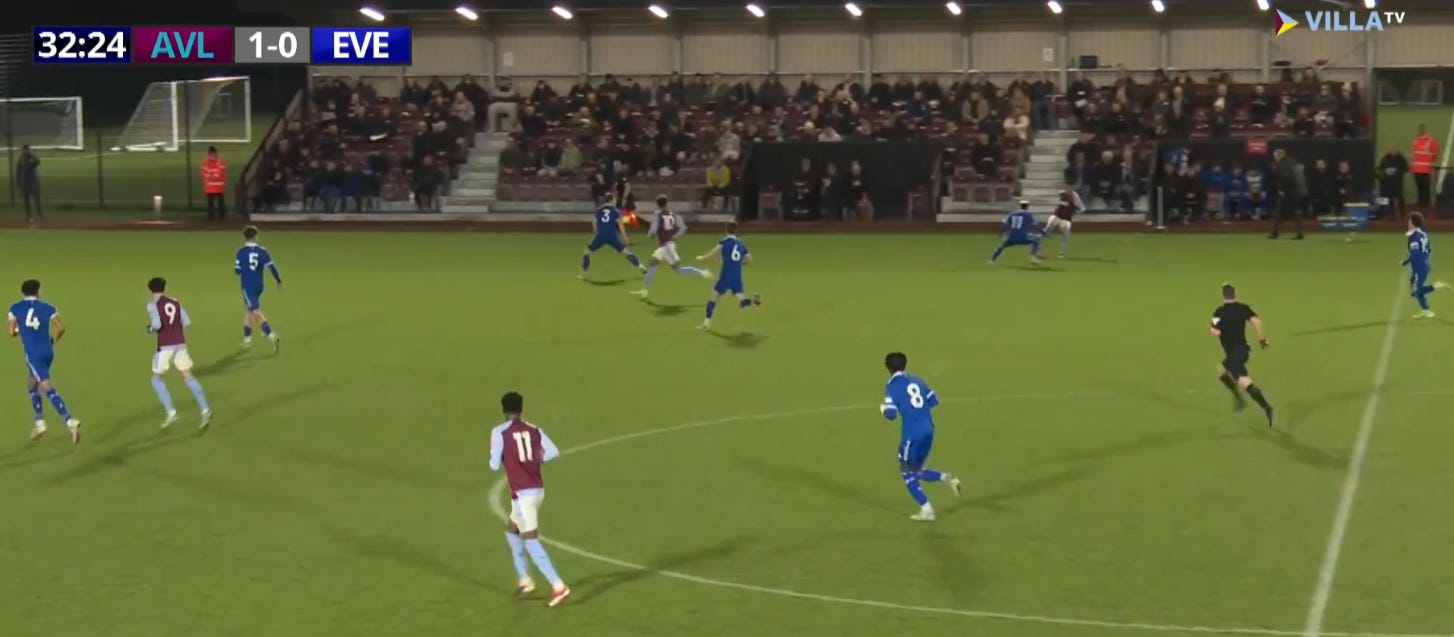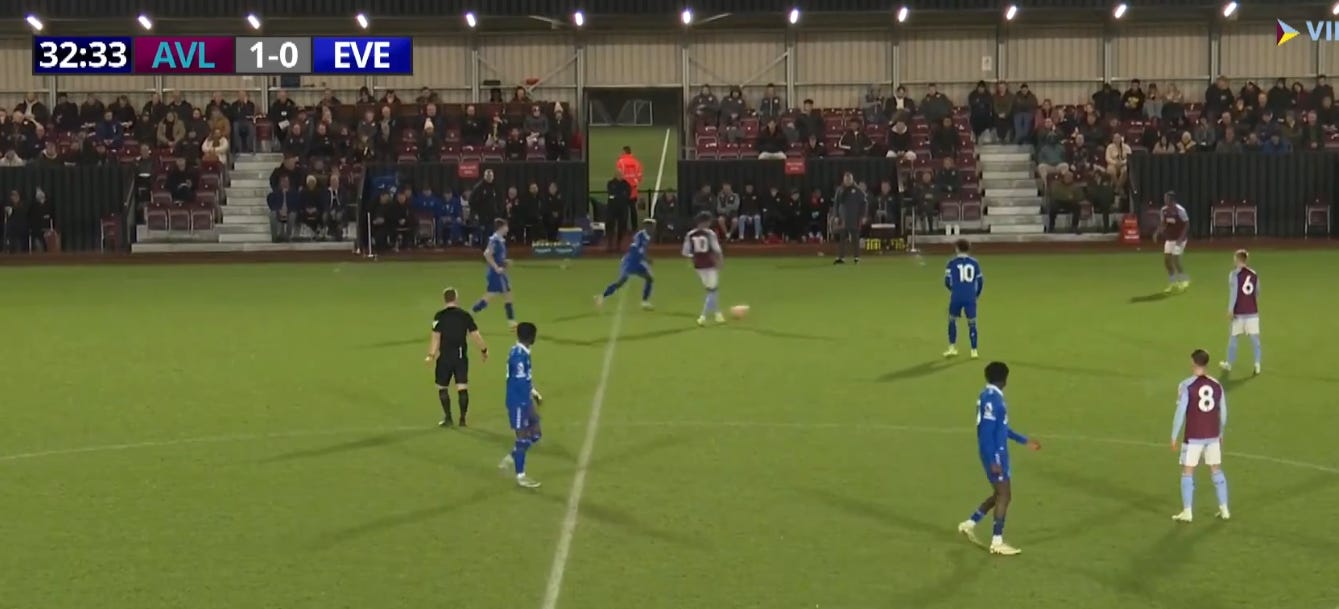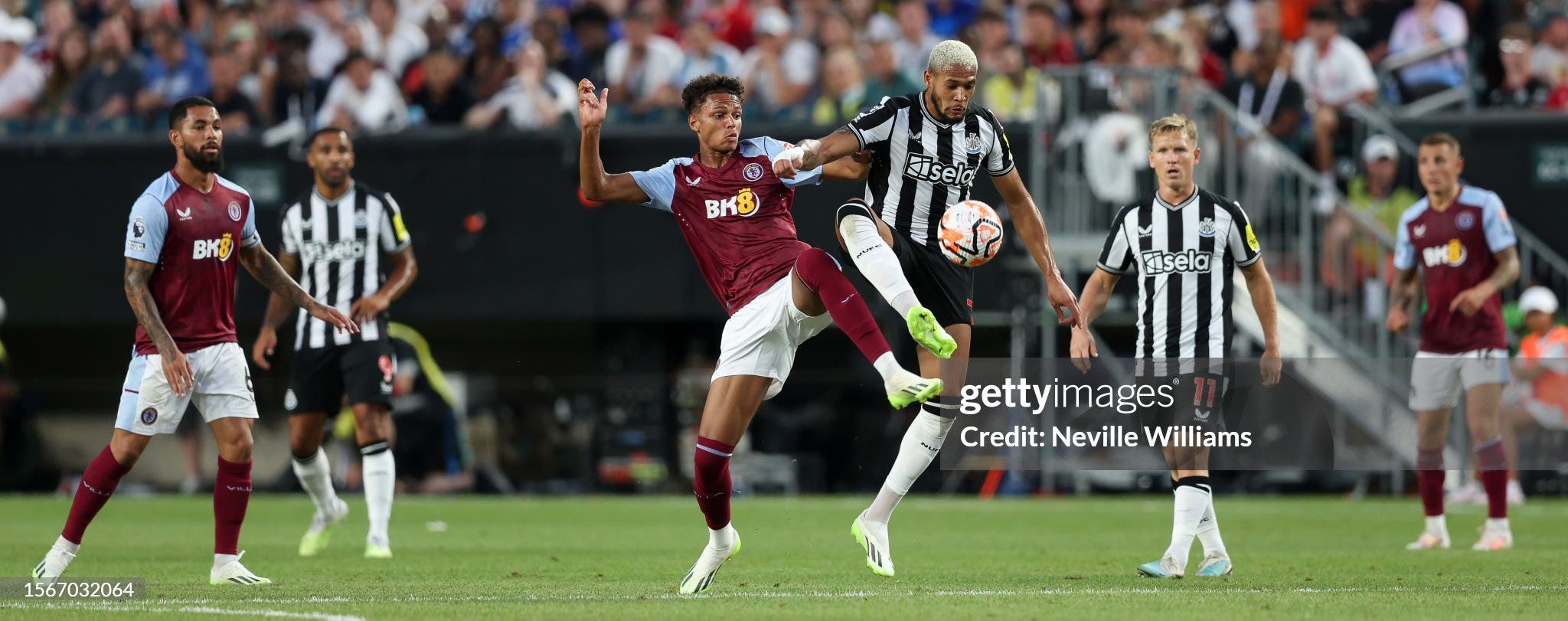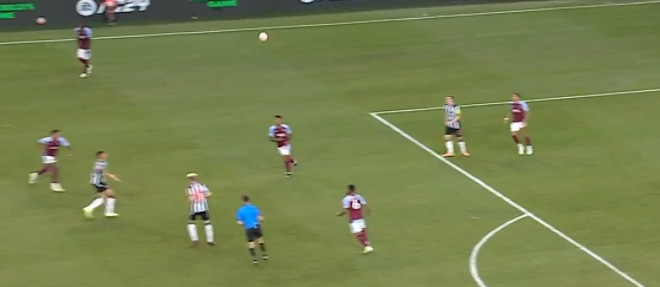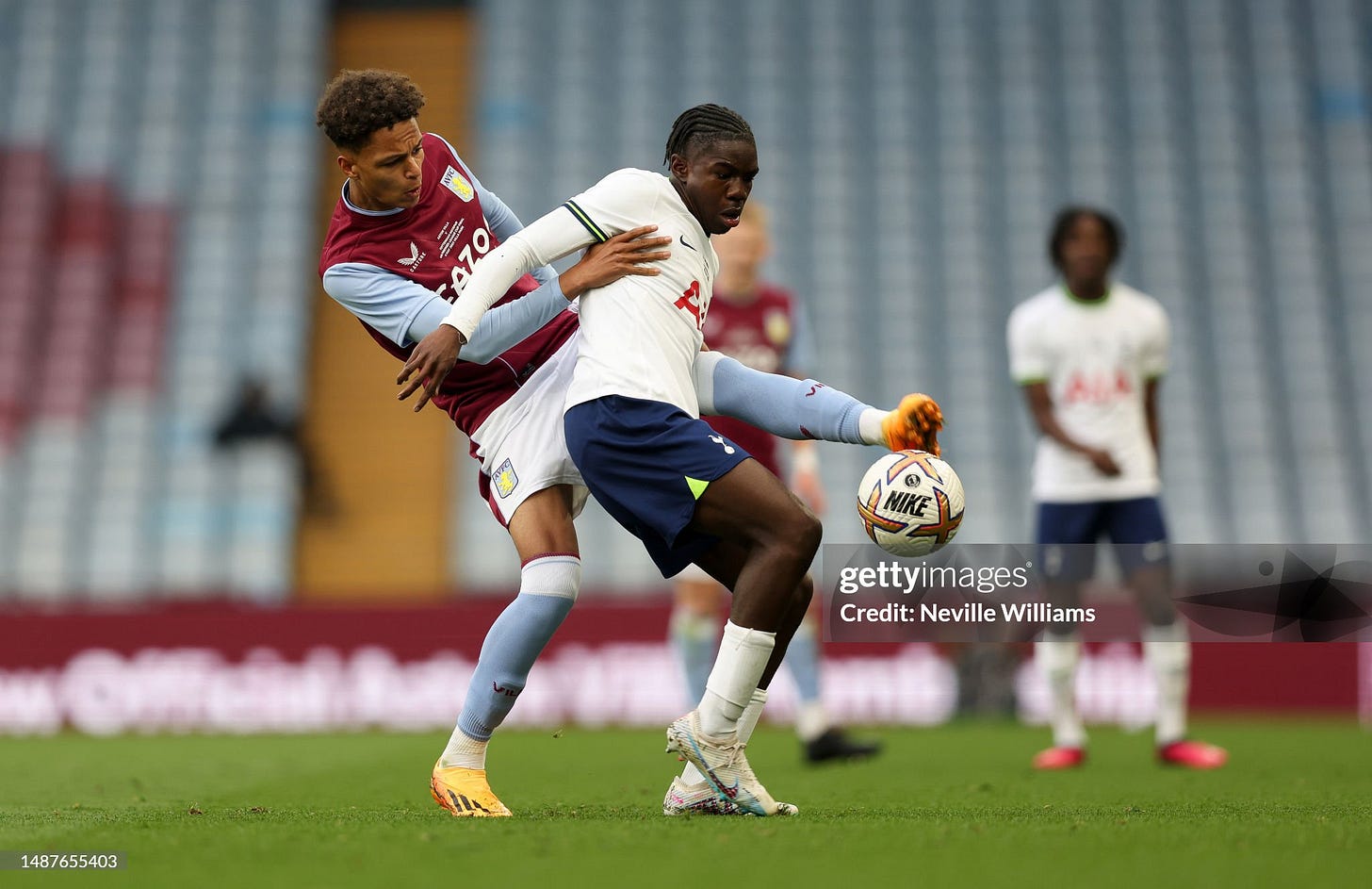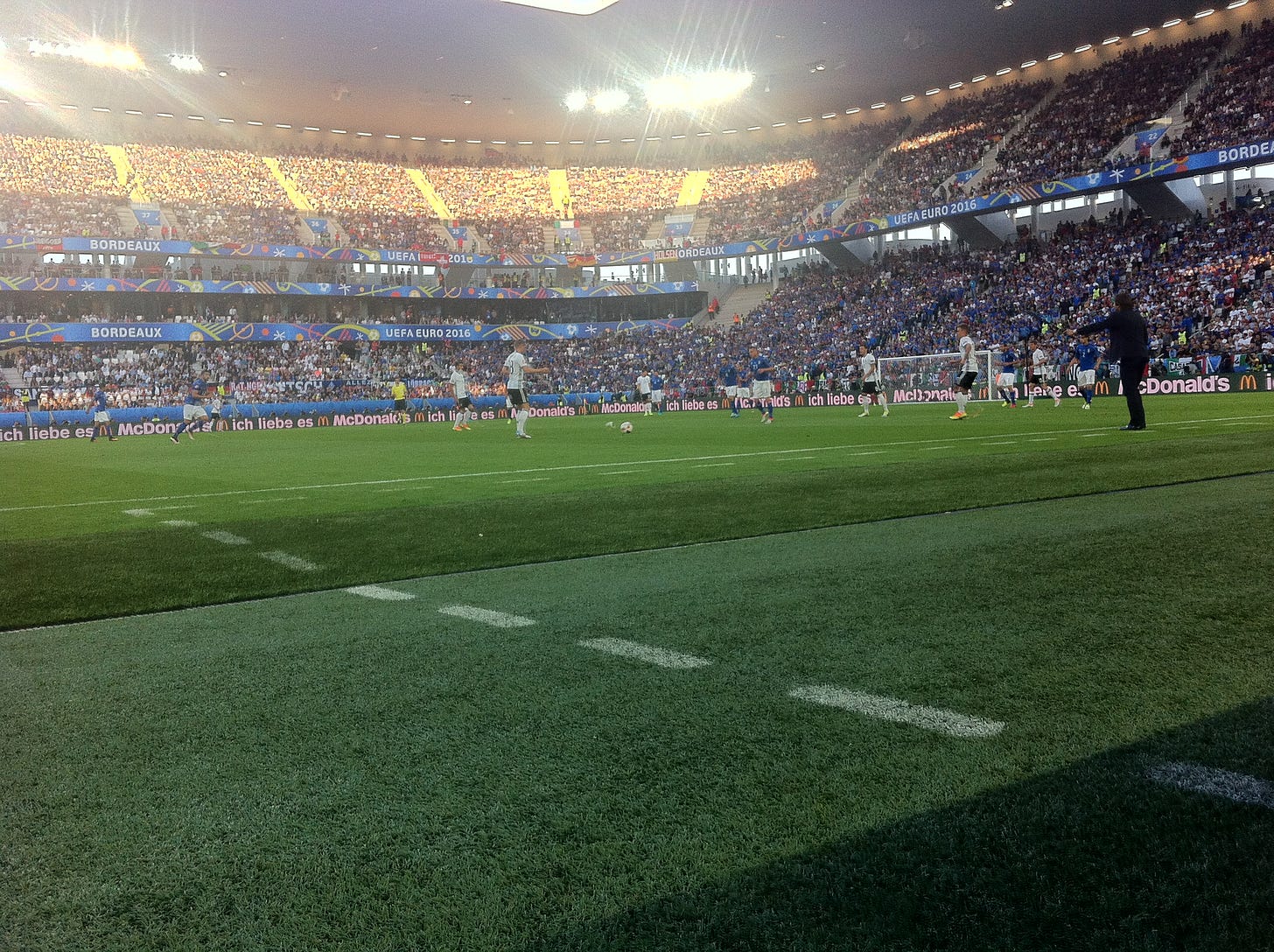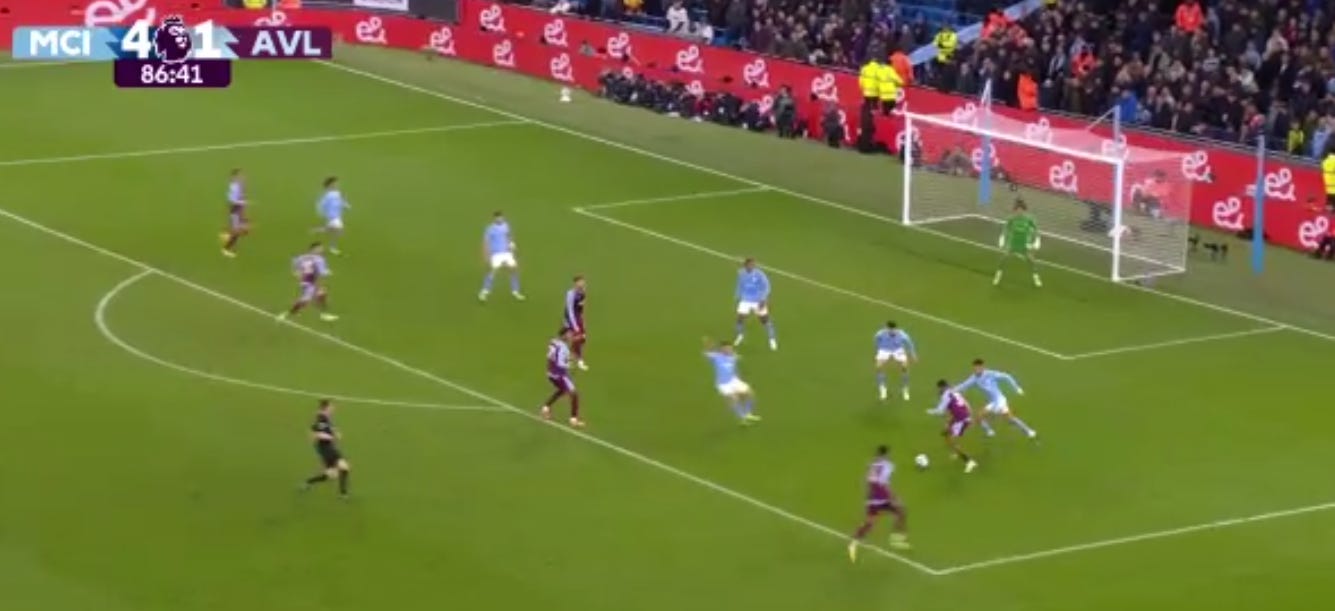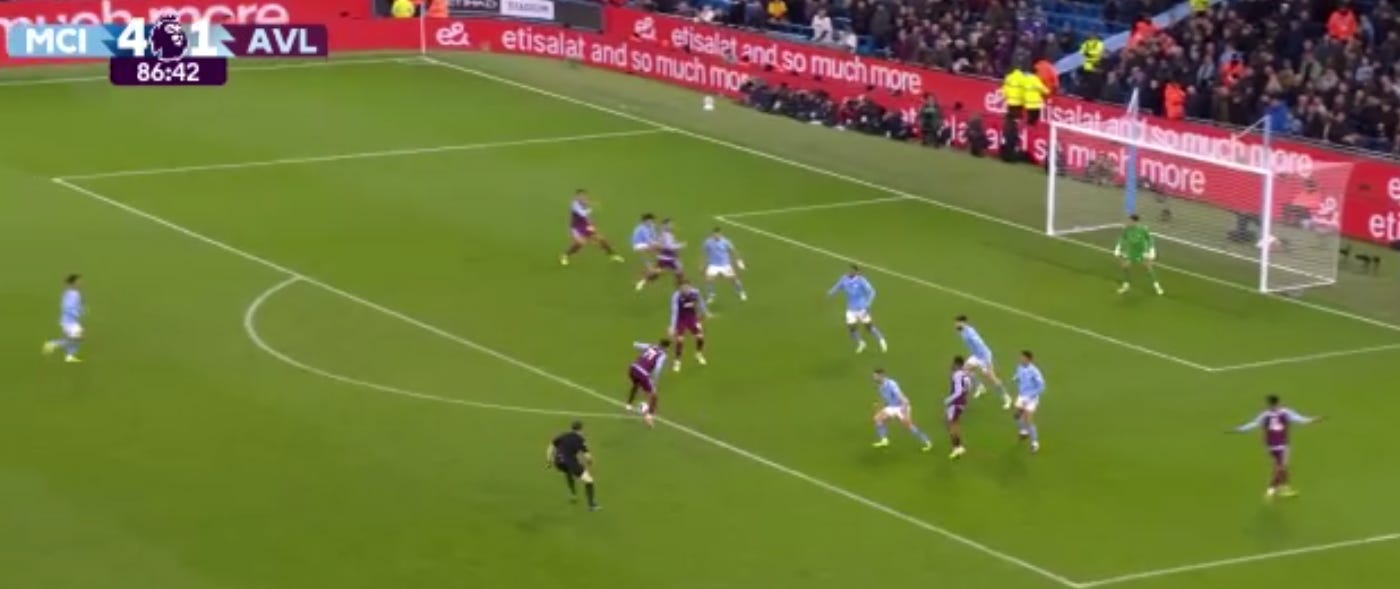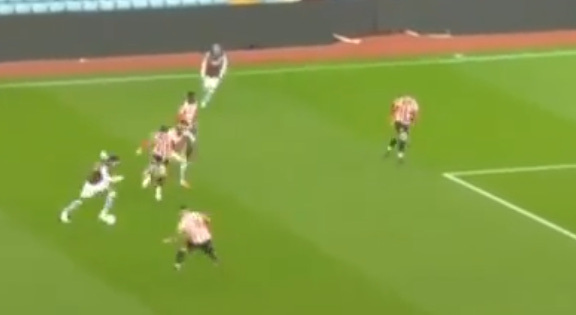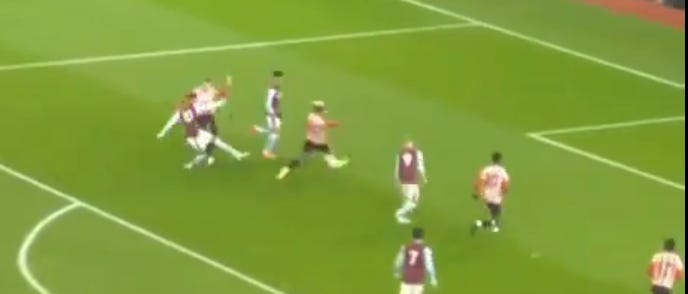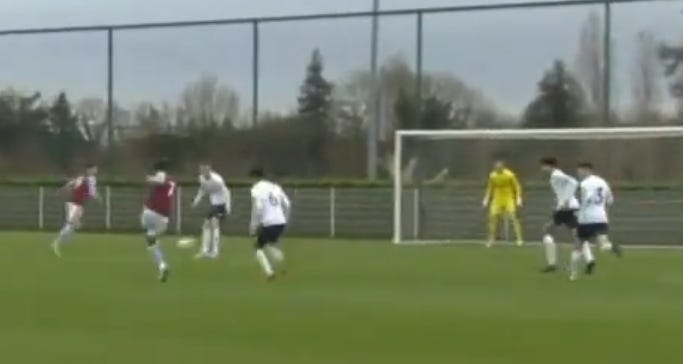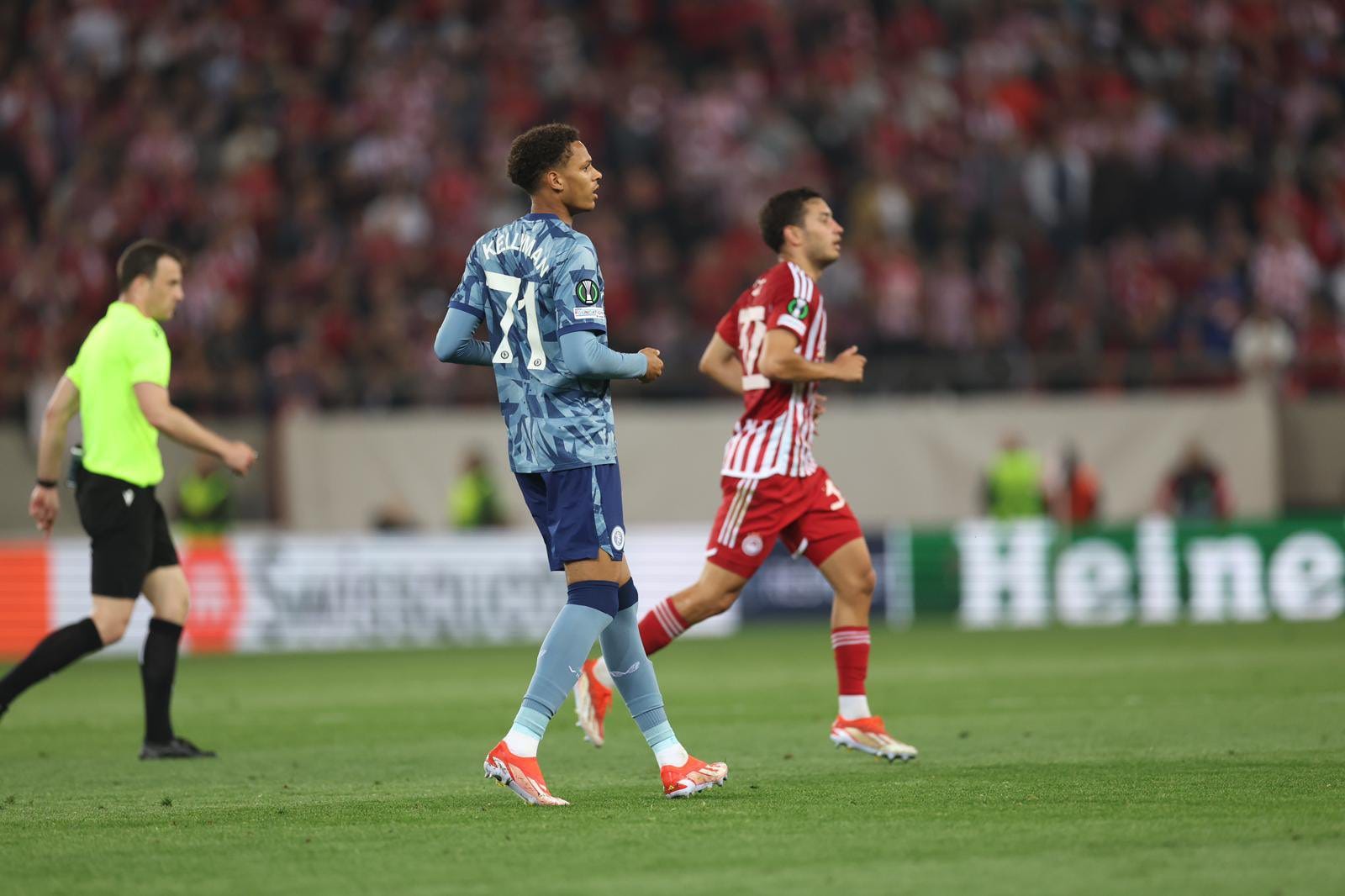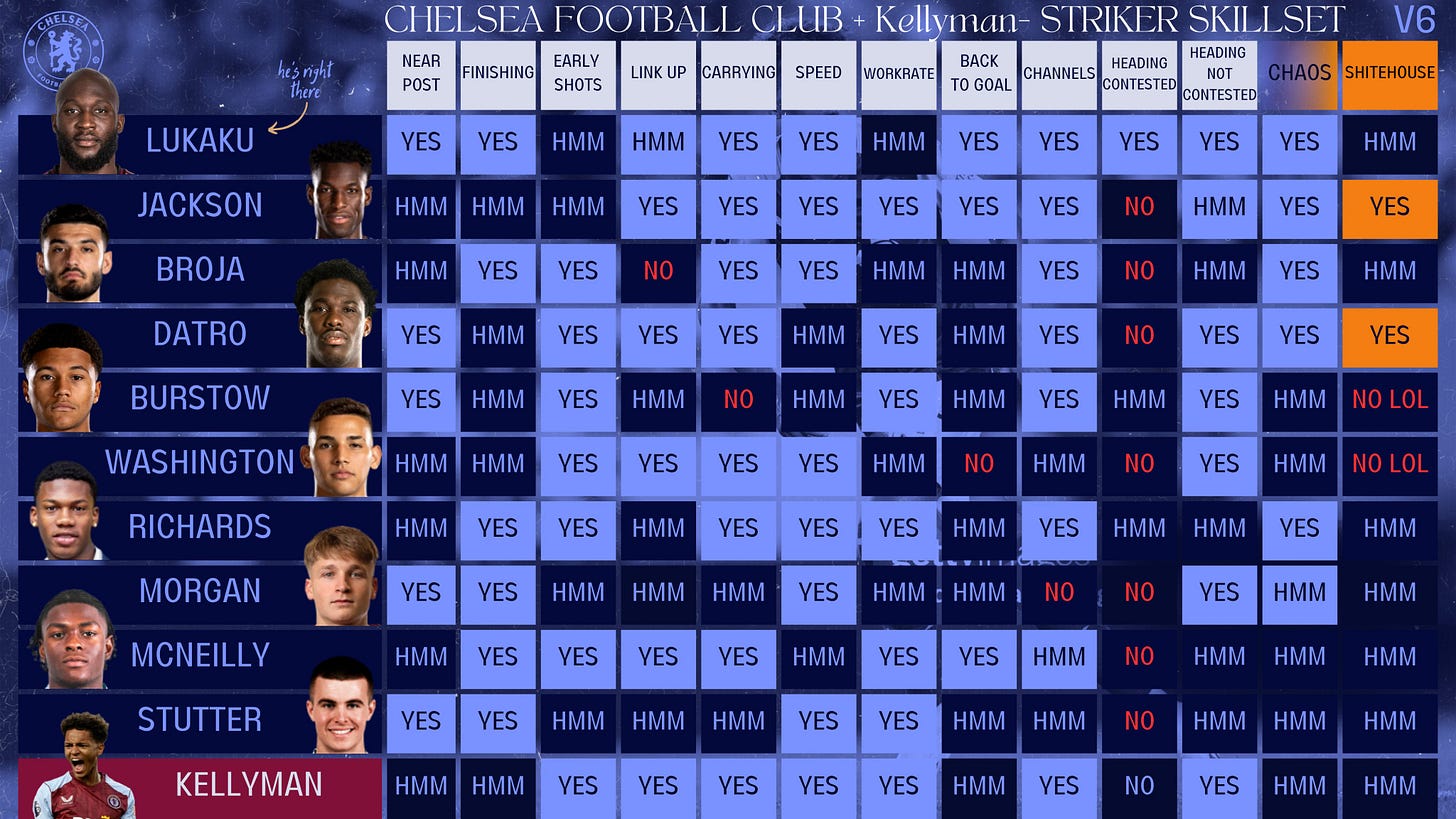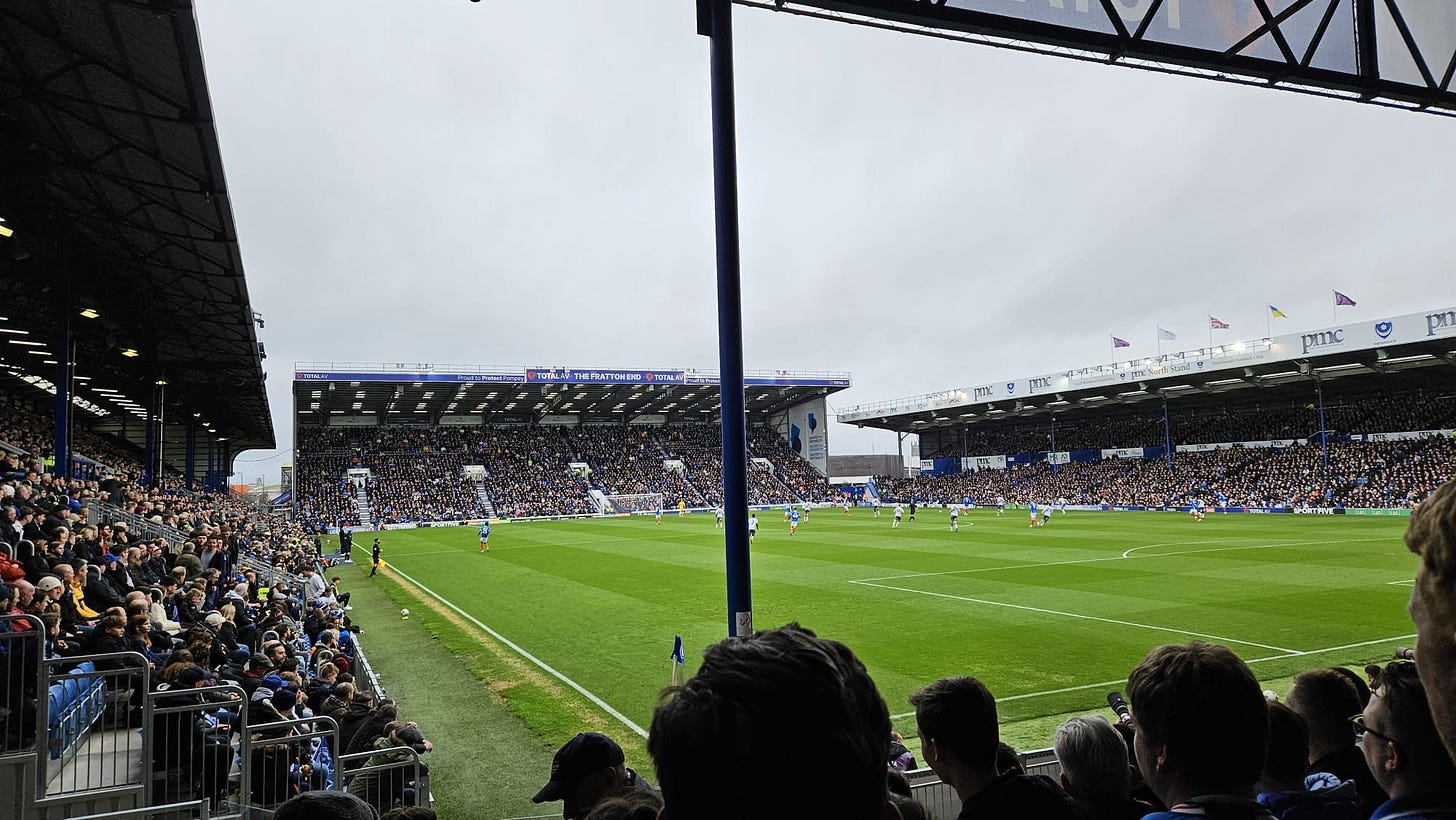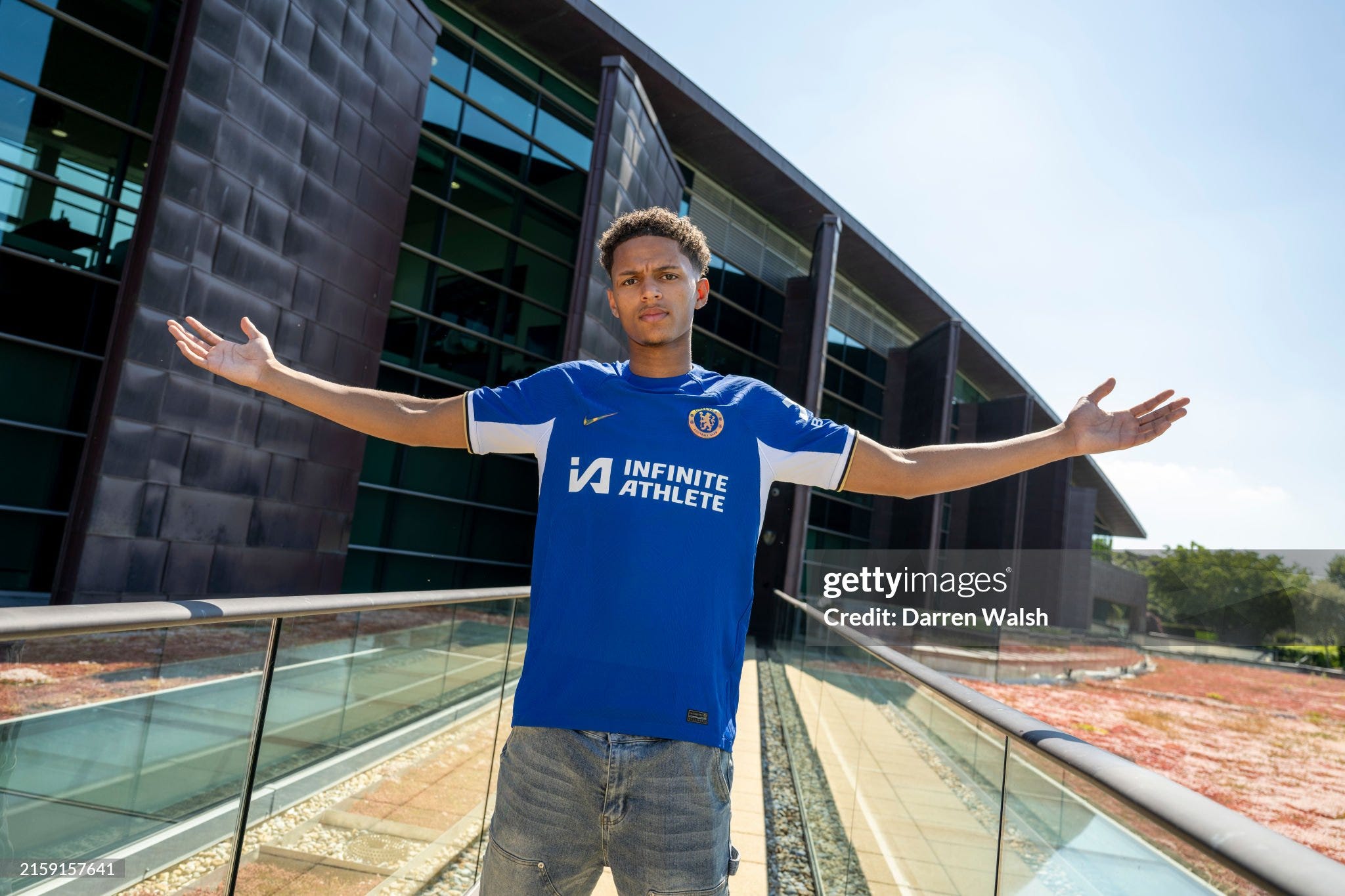✨🦎Striker focus: Omari KELLYMAN
can you shoehorn a 100-pt team through a loophole? perception-action
Chelsea’s financial shenanigans continue, as they’re trying to shoehorn their 100 point team through the latest financial loophole to date;
Long rumoured to be interested in Jhon Duran, in what seemed way too sensible from a squad building standpoint, Chelsea’s pump faked their interest in the turbulent Colombian by discreetely turning their attention towards Omari Kellyman.
You’re meant to think that 5ft10 Maatsen’s 35 million move to Aston Villa, and Omari Kellyman’s 20 million move in the other direction are not in any shape of form related. Some information here might be inexact.



None of this reinvigorates our love of the game, not more than a once feared sporting institution now languishing in 12th place whilst actively cutting ties with every functioning stakeholder with a track record of success.
Replaced by “elite Tactical ID”, “loopholes”, a process that ought to be “trusted” involving “infinite athletes” (on infinite contracts).
But at the end of the day, we notice a lot more fairy glitter flying around by namedropping eye-test friendly players to exhilirate a guillible fanbase, than anything of note.
Or merely settling for the ersazt or players that look stylistically or vaguely similar if you look with one eye closed.
Signings standing between the lottery ticket (200 minutes for an Argentine CB) and the can of Canada Dry (looks like some, but not quite).
Or maybe “re-create on the aggregate”, who knows.
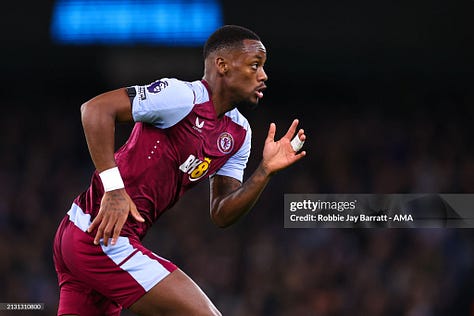
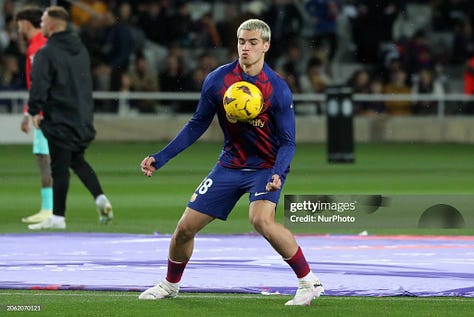
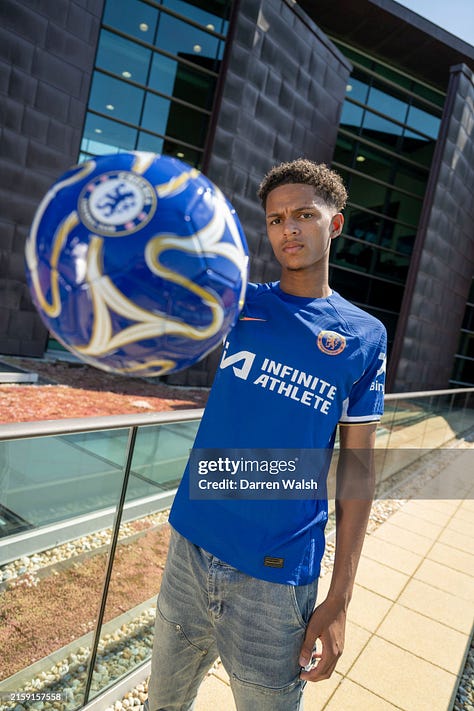
In that process, Chelsea tumbled on their third choice Mauricio Pochettino (Enrique was #1, Nagelsmann was #2) who found a working formula with that concept car not without pointing that there was missing elements.
And more importantly, shielding that flawed squad all season, taking the flak he could absorb (or maybe that was the lemons, who knows).
What do you make of RockStar games’ PR following the leaks of half finished footage of GTA on Reddit? A bad look for everyone involved, that could lead to losing a competitive advantage (earned, and cherished).
If Lewis Hamilton needs to snarkily suggest your car is missing pieces, what does that say of the process? And how much layers of the process it was allowed to go through untested. That’s the Ransom’s Swiss Cheese Model. With NFT cheese.
Both would either suggest a complete lack of accountability, with the decision makers tasked to avoid the iceberg before the “PSR deadline” being the same who set course for it, with a squad designed in spite of any common sense. Tall and goalscoring midfielders? Why would you do that.
Or precisely following “the plan” to the letter (tie players dumb enough to accept these long contracts on low wages, and run some cute accounting profit at the first opportunity) because it’s not explainable otherwise. Worryingly
There’s two things to “experience”
You’re experienced if you’re good; because if you are then you are on the pitch from the point you can make a difference against senior players, age 17 onwards. Lesley Ugochukwu didn’t need “the perfect system” to lock PSG three times in two seasons at 17.
You’re experienced once you’ve (been) rattled enough (times by) seasoned professionals and learn(ed) the required gamemanship, to draw a foul, use your arms, pull shirts and disappear to only appear when it counts (as opposed to the other way round)
There’s a reason certain players who received La Masia standard of coaching, being in their U14 season when the club’s U19 team reached the Youth League final (2015) - never completed 10 games at senior level as of 2024.
Experience, really, is the corporate way to say “quality”, margins are too tight, anyone who can help a team win games gets his minutes (and his money).
Quibbling over one or the other suggest either the player “isn’t it”,
Or that decisions makers are really convinced that they cracked the code of an industry running for 150+ years because they’ve got WyScout and spend 17 hours at the office.
Consequently, you can have the best left footed right winger in the world playing in the club next door there for the taking, and decide to turn your nose at the prospect of signing him by throwing enough spanners in the works to piss off the agent. Football is the biggest loser, and the card castle welcomes another extension.
Or penthouse.
Paying below market value (no matter how much clout it gets from influencers / advertisers) only has one outcome; to get average output down the line.
Or only for a short while until doors are broken into and amabilities are exchanged around a table. Yes, they’re all rich, but between clubs and players, one lowballs the others more than the other part and it’s not the players. See Edouard Mendy’s contract
Which brings us to point 1: pay good money, get good players.
If you bet on the right horses.
You can also target the specific, uneducated, poly-advised and/or dumb-dumb specific market demographic that’s easy to tie to the deal you want.
But pampering a foal won’t make him a racehorse the week after.
In terms of squad building, the league dictates what the squad ought to look like.
Listen to Fabio Capello, complaining that his own country fell into the Pep Honeytrap from 2014 whilst he now plays a back six of 6ft3 centre backs and a big man upfront.
Striker skillset is the identification of the know-how required to impact PL games
Player profiling is the identification of individuals who help the team in these identified situations related to certain matchups.
Take Formula One: that they regulate the number of tyres used is one thing.
Do they need to specify that teams need one of each, in order to define their strategy (and wet weather tyres). Not necessarily, because teams aren’t stupid.
Chelsea, on the other hand, made the mistake to listen to the football expert at the club, who thought wise to discard Tammy Abraham, Romelu Lukaku and Olivier Giroud, to clear the red carpet for Kai Havertz and sign Aubameyang who didn’t reach double figures in terms of shots on target.
No tyres? No problem. Shoehorned between 1921-22 and 1923-24, you can find the the 2022-23 season with 38 goals scored, as if football script writers felt humorous.
From that point onwards; any forward being signed by Chelsea, looks an upgrade not in terms of quality, but numbers. Datro Fofana made a promising, chaotic but all action impact on his first games after joining.
Mason Burstow equalized vs Dortmund in pre season and came on vs West Ham when trailing, started the League Cup tie vs Wimbledon.
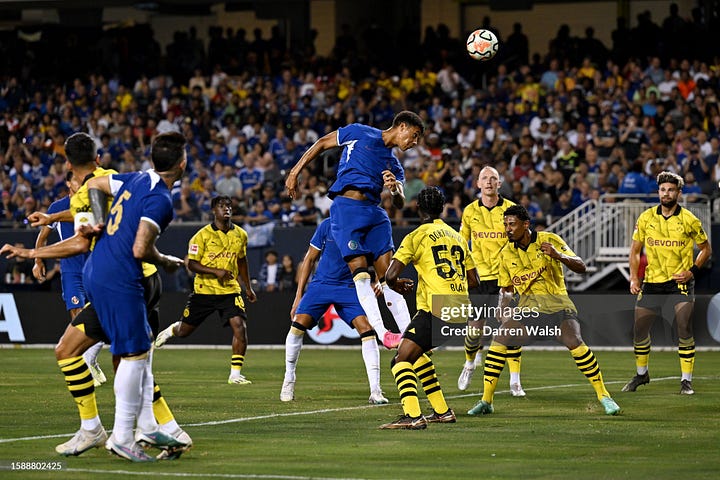
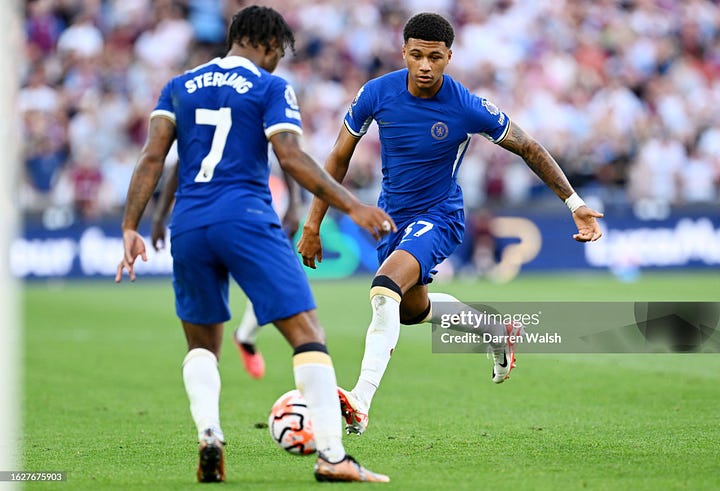
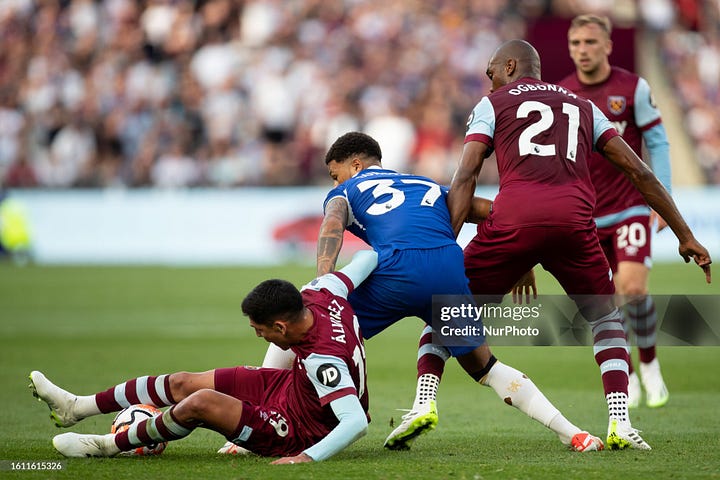
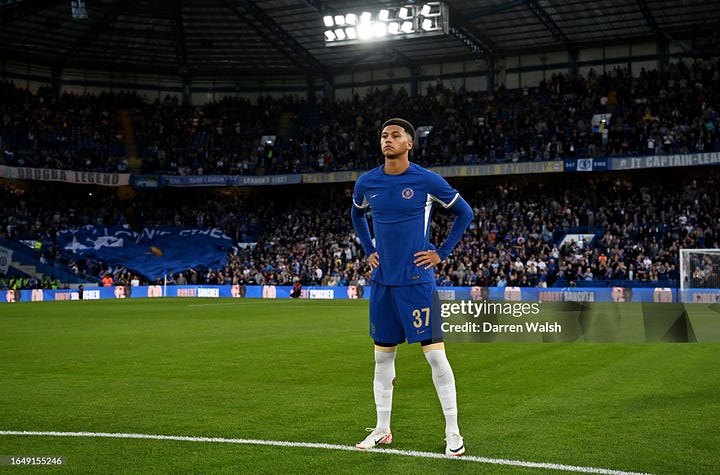
Were either Datro or Burstow ready yet? Not really, but as the next guys in line, they got their chance.
This is where / how Kellyman would stand, the general idea being “would you make a difference on fundamental striker plays”
“giving a run of games” to players woefully out of their depth from a quality, gamemanship and ability to handle criticism will create a bad spiral sooner than later.
Sunderland AFC - sacking Tony Mowbray, the equivalent of Mauricio Pochettino: old head, playing good entertaining football, universally respected in the game and giving lot of debuts to young players he mentors and shields from criticism.
Relegation form since Matchday 25. Playing the youngest ever Championship lineup.

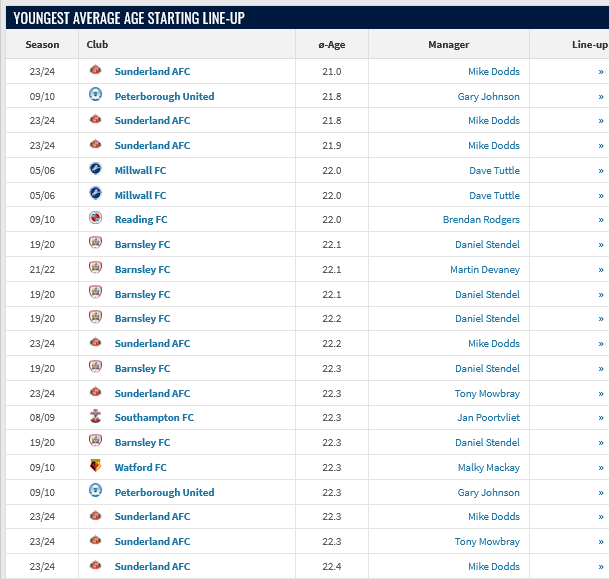
The game?
I was there.
Have never seen such a disjointed team at professional level.
Talented Mundle and Jobe scored great long rangers after a string of passes for Sunderland that day - but carved through easier even than hot butter sliced with a laser saber in a nuclear powerplant
You must wonder: what’s all got to do with Omari Kellyman?
Well, nothing, and everything at the same time
Omari Kellyman finds himself being the chess pawn in that game involving people who know better (than to crowdsource transfer suggestions from the social media cesspit - Liam Delap when).
That’s on brand, to play under a coach who genuinely believes humans and pieces of wood manipulated by a god-like figure without any justification to anyone but himself relate in any shape of form.


Roll on Modern Football, where Lyon made 7pts in December, Ajax was rock bottom with a sporting director swiftly booted out after a 100 million splurge and the likes of Lyon (who needed to splash 30 million on Orel Mangala in January to narrowly avoid relegation), Lorient (going down with the 9th budget), Southampton (Me and Mr Jones ; “me” being the instruction to play 442 and Nathan Jones losing 11 in 12 before getting sacked) or Sunderland (3 coaches in a season, aired by everyone since) are happy to push-over the line appointments who sold their credibility a long time ago.
For the mere thrill to sit on the bench (but unquestionably instrumental in deciding the menu for pre-game and half time snacks).
All behind the curtain and PR smokescreen of “the best backoffice in the world” (or “let us have a go at the big boys playground”) with the composure of a kid finding his parents’ bank card. At some point, the chickens come home to roost. In separate deals.
Maybe Omari Kellyman will go on loan.
Maybe Omari Kellyman won’t go on loan.
These are some notes collated on Omari Kellyman, of things he does well, that he can improve and how. And generally, what kind of player he is.
The stylistic comparison with Kai Havertz or Cole Palmer is inviting, as that tall, discombobulated left footed player gliding between both boxes.
From what I’ve watched so far, I think Omari Kellyman has a lot of good ideas to make attacking moves work. Keen to get on the ball, and find space on the pitch.
These are two different aspects; albeit the outlook is similar.
The former relates to self confidence (Palmer, Hazard), the latter does too but relies on situational intelligence to find space expertly (Gallagher, Nkunku).
We feel Omari Kellyman is (unsurprisingly for 18) currently let down by the way he gets challenged on the pitch, which he will need to get better at, though the timing of the release and decision to stay on the ball - a lot.
I advocate for carriers who change the picture, for avoidance of doubt.
But end product will be the difference maker, as any attacker making the pitch at PL level needs to at least get one goal contribution every 3 games.
Mitchell, 4 seasons of Premier League and a stiffer arm than rookie Kellyman.
Which one has shoulders over toes (balance)
Fouls drawn is one indicaton of a player cristallising attention more than the others (which is good, as opposed to never getting the ball), which is meant to transition towards being able to “get fouled professionally” to draw the free kick and avoiding un-necessary bruises.
Players who get kicked from pillar to post are either robust (Jackson), or learn to avoid door-hinges.
Watching Ukraine vs Romania in the background and imagine my surprise knowing Mudryk is unable to play an important game because he put a random body part in a door hinge during the week in training - once again.
Situational intelligence might not lead you to send a man on Mars, but certainly enhances the flow of one’s day to day activities by giving you access to opportunities, when you don’t bruise your toe on the bedside table on the day of an important meeting.
The underlying point I’m willing to make with Kellyman resonates with the one that was the story arc of the Deivid Washington article.
What are you doing here - covered extensively above.
Do you play the way you look?
If not, can we really trust you to make the pitch?
You can engineer the first aplenty. The second belongs to the playrs on the pitch.
Their perception, their actions.
What did you say? Louder I can’t hear you on this part of the pitch.
The problem Deivid Washington faced (which prevented Pochettino to give him minutes), is that for a guy well over 6ft, powerful and deceptively rapid with an excellent first touch;
you expect: “ball retention” “selfless runs in behind to stretch the defence” and “stay on the ball, draw fouls” and possibly “flicks” from the looks of him - also from a team mate’s perspective.
None of which happened to the required standard (did not in PL2, we ought to respect the levels as opposed to thinking players scale up because the agents or whoever convinced you they would.)
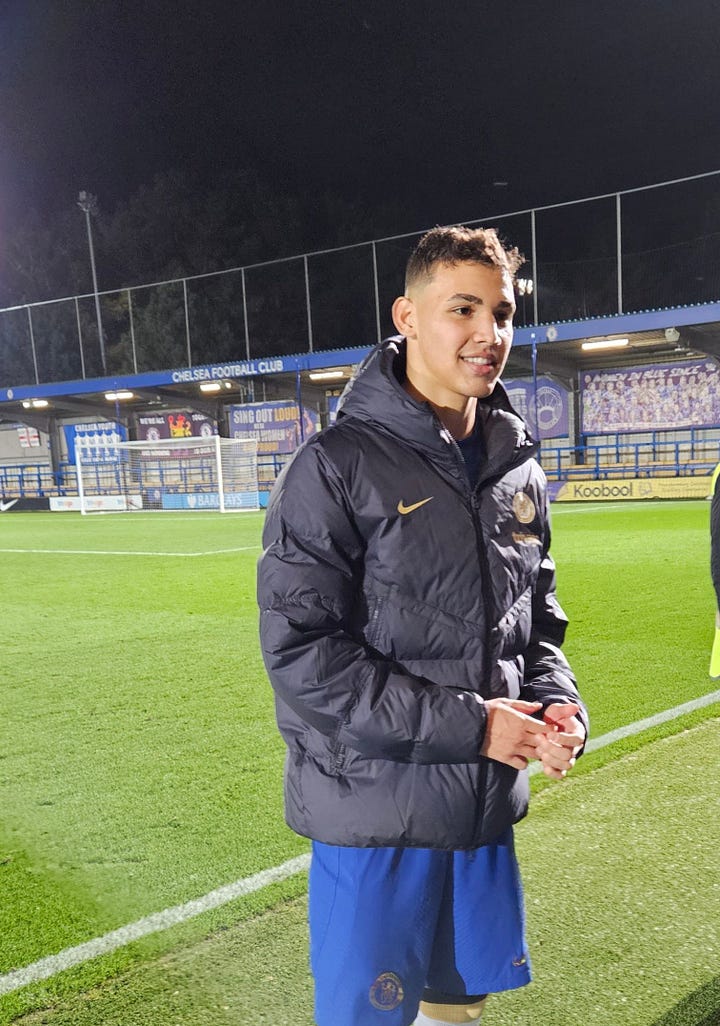

We see a plant blossomming, will it be a turnip, a pumpkin or a dandelion?
Will it be able to build Castledine the sky?
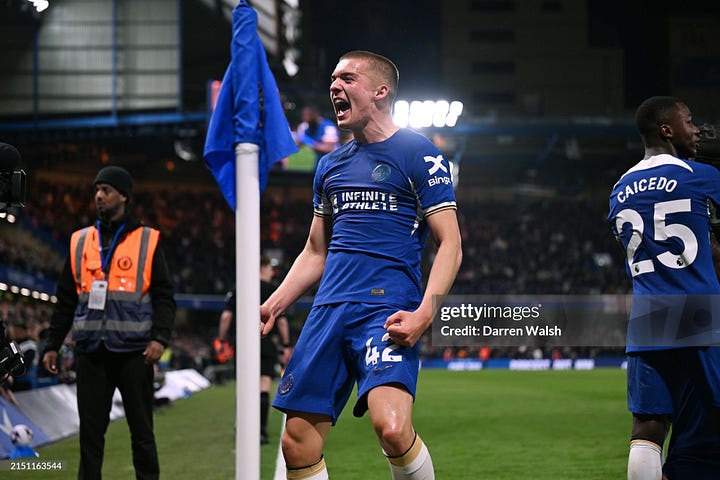
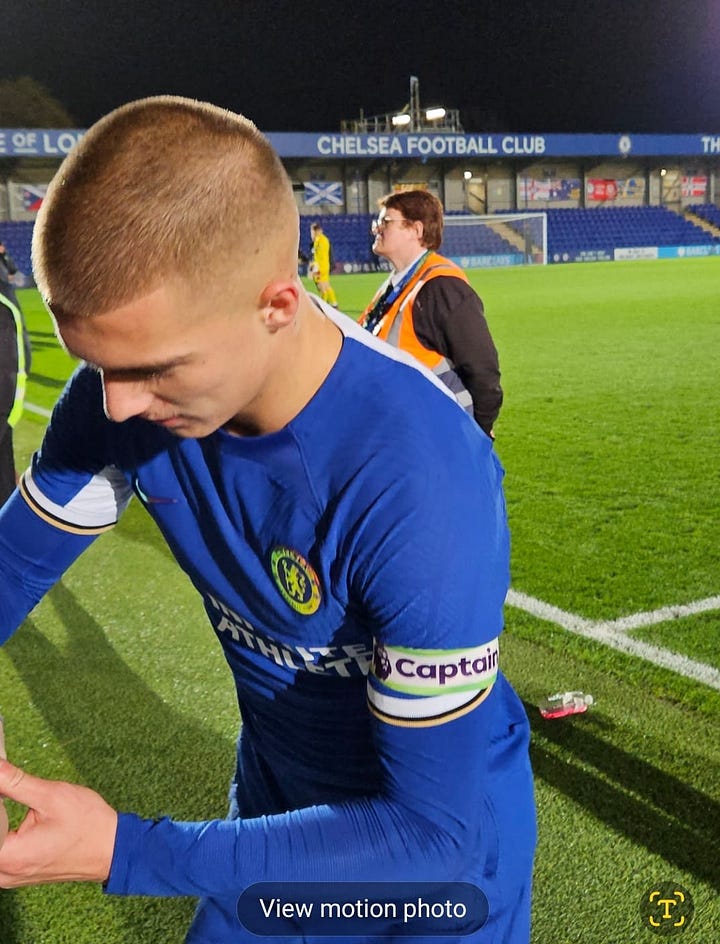
Alfred Gilchrist; what you see is what you get, fool-proofed by 5 or 6 weeks of training (and not playing) and subsequent reactions. Least we forget that up to U16-U18 players play every week, and their U18 season is crucial to their development and the way it’s managed. A player might start training with the U18s, then train / play with the B team then train / play with the First Team in the same 6 months.
Corporate knowledge and the right processes in place are fundamental to manage it as best as possible for it to make sense
Omari Kellyman got introduced away at Manchester City for his PL debut and played the dead rubber game at Crystal Palace, and was also involved in pre-season.
Whilst it’s common for clubs to put their best prospects on show, player buy-in is fragile and clubs have competition for places. Not moving the needle is a challenge that can be mitigated / watered down by a 10 player carry job.
Now try to over-promote a youngster who acts up anywhere but by delivering on the training pitch, and see your senior players’ reaction.
Point is; yes, there’s always an element of club politics at play; but primarly sporting merit.
Even from Unai Emery (don’t look at the substitutes bench at Selhurst Park).
Separation movement
Happy coincidence, Kellyman shared the pitch when Youri Tielemans was wearing a body camera for the Premier League Summer Series fixture, which offered a fascinating glimpse of the time / space pressure top level footballers are subjected to.
And a gentle but necessary reminder that football, or sport, or any situation in life is involving what’s called the perception / action coupling, as part of the “ecological” paradigm that - really - once you get familiar with it, acknowledge how utterly common sense it is.
Players don’t measure distances between opponents, calculate the barycenter and run a script to see: 0 there’s no team mate 1 there’s a team mate.
Three opponents is a space to hit, two opponents and the referee doesn’t make a triangle.
Doorey, M.. "James J. Gibson." Encyclopedia Britannica, April 30, 2024. https://www.britannica.com/biography/James-J-Gibson.
There’s scientific literature in the field of learning for the past 50 years, Football is just very far behind giving credence to outdated coaches (even being born after these articles were published) putting a new coat of paint on “write the alphabet to be able to read” and other “copy books to be a savant”.

Football isn’t a performative sport. Think about your efficient / enjoyable learning experiences, or have a look how Duolinguo does it: fun problem solving games.
Experts are able to master a complex environment, by picking the relevant cues in the environment and making the right decisions. Matchday stewart, lifeguard and of course granny at the market smelling fruits and veg to find the right ones.
The ultimate best players in the world are able to process one pass, in order to foresee the next one and maybe the third.
example: if I play A instead of B, A has a support option, B is isolated. A can combine with to C and I can ask to C or expect C to find another runner.
This is what a player sees. Not your shitty powerpoint diagram, not your modern art installation with mannequins in training.
Players find separation during the pass from A to B.
C gets on the move during the pass from A to B so that he creates a yard and C can pass him in 1 or 2 touches.
“trigger your run when B gets the ball” - is already too late
On the field of vision, from the Georg Ilenikhena article
To simplify, there would be a
narrow angle where players can see / read / perceive
A wider angle where players can see shapes, movements and colors
the far peripheral vision; sometimes impacted by fatigue (and it narrows).
Expertise is:
Pick out the relevant cues in the direct field of vision
Be able to abstract the direct field of vision and chose the relevant cues in the near peripheral vision. Yer da reading the newspaper, yet seeing you sneaking towards the fridge. Because he sits in the same strategic spot on the couch to oversee the households’ proceedings, he’s got a library of similar/relatable experiences, albeit never identical situations which makes it easier for him to notice anything unusual.
What’s my blud waffling about? It’s the same for 3v2 waves. Relatable, never identical. Do it more, improve players. Throw shit on the wall until it sticks, the next one needs to clean up before delivering the football training session.
If you’re washed up, or unfit, you rapidly merely only discern shapes moving in a state of dizziness.
Yes, Pochettino hammered them with 2v2.
Didn’t hear your loud mouthes complain when Palmer played a 2v2 at 90+10 to shoot through André Onana’s crippled gloves. Unrelated. Championship is 46 games not 25.
“tactics” are not really relevant when players can bomb and cover two areas, hovering over the pitch.
“running” is hella important when your “tactics” get found out.
this is the reason players like McTominay, Matuidi, Gallagher are picked first especially when tacticoachs’s buildup is found out. Because if it can be described at lengths by sport science undergrads on social media, so can it be by players themselves in a heartbeat.
“Dougy” plays a pass a bit square, a bit behind-ish to Tielemans who won’t have the direct picture
The affordance isn’t what, you, outspoken watcher, second guess on TV
Doorey, M.. "James J. Gibson." Encyclopedia Britannica, April 30, 2024. https://www.britannica.com/biography/James-J-Gibson.
The affordance (coined by James Gibson in the 1970s) is:
Omari Kellyman’s availability
Tielemans’ ability to pass
What the environment affords at this very moment. Is the pass realistically playable, or the risk of turnover too big.
Kellyman is on this picture. Playable under certain conditions, that Tielemans doesn’t consider as met.
In other words: affordances depend on players’ perception x the environment
Look at Richie pressing: make yourself big, zig-zag, open arms to screen the field of vision.
Tielemans’ can’t run. But his science of the game is one of the best seen in the past 20 years in football for where / how to play, what rythm etc… ; backed with a fine touch.
Tielemans backtracks to create space behind the Newcastle’s mifield (and stretch the pocket where Kellyman can ask the ball.
Receives again from Douglas Luiz.
Look at Gordon’s pressing now: he’s late as he should be decelerating as Tielemans has time / space in front. Body surface not wide.
Tielemans intelligently clips the ball over, as the problem of being closed down is solved (Gordon’s pressing is not as good).
Kellyman however decides to go back foot back to goal.
Because he’s long, and has long limbs, it’s still difficult for the defender to get in front.
Ball bounces between his two legs but he’s losing territory
Front foot keeps the ball far away from the defender, back foot doesn’t
(when receiving back to goal with pressure - this is a situational “rule”, not general)
Tielemans’ feedback is “pass it, and away”, not in a negative way but to keep the ball moving.
If you are to retain, keep the ball at one height, fine.
If you lose ground, dump it and go away
Attackers who can’t retain the ball usually get these unclassifiable plays, which Havertz was (still is tbf) fond off. Carry backwards, spin, and dump the ball one yard.
Imperceptible needle moving. But it’s there, look closer.
Goalposts don’t move. Only Taxi Drivers do. They need to understand and grasp your gibberish at peak hour, otherwise it’s not relevant.
Seconds later, Kellyman trusts his team mate to split Almiron and Gordon to receive in the space that the two NUFC players are willing to keep open (half spaces are not a thing - space doesn’t produce actions, players do - NUFC’s inaction here).
to find Cameron Archer’s excellent “hook run” behind the CBs
Archer is an excellent striker. He’s also shorter than Lascelles who has no issue to clip his shoulder to put him off balance and sweep, to win the ball back.
Height is often positively correlated with heading success (tall dude who can’t jump > small dude who can jump), but encompasses a lot of other aspects such as tackling reach, and who’s got the easiest to put the arm above the opponent’s
You can strawman informed people who call for “height”, or use your two braincells and acknowledge it usually comes with a know-how that is very much required.
Because nobody plays a NBA draft pick on the lose at professional football level.
They can head, get the ball back or score.
Can’t find one who doesn’t do any of these things.
Archer retaliates, and gets the foul called against him when Lascelles splatters.
A few moments later: as mentioned above;
Here, Kellyman is visible from his CB, and therefore unreachable (because will get jumped during the flight or when he receives).
That’s where deception, disconnecting from the flow of the ball to stay blind side is key.
These are solutions players are meant to find organically: if I stay at arm’s length of my CB, I don’t get on the ball.
What can I do to escape his focus to only pop up to show for it “where” I’ve decided.
A few moments later, Kellyman, not unwilling to track back and work on opposition’s midfielders, toe pokes a pass back to Tielemans.
This is the kind of play that gets plautits on a PL2 / Academy pitch, but is standard in intention at the highest level; and below par in execution here.
The ball can’t roll on the pitch, as it gets swarmed.
Looks like Gordon nicks the ball, that forces a turnover.
As for Kellyman:
Either receive, shift and turn in the open space
Wait, dwell and draw a foul
First time clip around the corner for the left back
None of this is a demolition; just second guessing wht can be the elements that keep each player’s busy at this moment. (in diz moment - gone but not forgotten).
Being “pressure resistant” means your mind isn’t weighing the swarming players factor more than they are worth thinking about; and technical quality means there’s no semi-conscious / active application to complete the pass. It just pops off the feet.
And for what it’s worth, a player can pass or can’t pass. Team effect is irrelevant, and conclucions drawn from statistical success rates can get in the bin.
Kellyman saw Tielemans, connected with Tielemans. There might have been other options. Players incentivised to drive with the ball until they can’t build up their character and self confidence to strech the boundaries.
Asking to pass and maybe carry if you wish isn’t conductive to empowering players.
Unai Emery is the best coach in the world to make average players look good and deliver video feedback. He’s also good people. But his glass ceiling will always be to empower mavericks especially those who don’t fit a framework, as his PSG and Arsenal spells (albeit never as bad as portrayed) showed.
Nicolas Jackson, Chelsea’s remarkable all action carrying and dribbling outlet, couldn’t find a run of form until Unai Emery left Villareal.
Speaking of going against the flow.
A rare Sebastien (Revan) passes the ball back inside
See Cameron Archer going “against the flow of the ball”. That’s clever separation.
One sticking point for young players nowadays, is to produce these annoying “half” separation runs (below)
Not because it’s in the “half space” (space doesn’t produce actions, players do)
But because they’re half asking into feet, half into space in front.
I’ll go if the ball goes, but I’ll still entertain my Neymar arc
Be readable for your team mate, with sharp darts for or away from the ball
If you trust your team mate, get away from him, that’s as much space available to show for it to help him in a moment.
As opposed to clog the space to level down to the worst player in the team, and ruin every option.
New instance:
Cash squares first time to Tielemans.
The salvation doesn’t come from “the circuit” but players' being empowered to be part of a serie of actions (A to B for C), therefore with a mental intensity that keeps them switched on and involved (because they own it).
That’s top level football. Cirque du Soleil isn’t.
Kellyman’s senior cameo showed promise, even quality.
The footage evidences how quickly decisions need to be made for team mates, that’s usually the biggest challenge for excellent academy players.
Tielemans hasn’t got time to fuck about to find out if Kellyman’s open to receive, he has to perceive a claret and blue option ready to receive so that he can bounce in one touch or take a second and play the give and go.
To avoid confusion: Kellyman is keen to get on the ball, has got nice separation moves.
That’s a good base to start, not everyone has the character, and agility and range of movement to do it.
It can become better over time, both in terms of timing, than bracing himself for “impact”.
Pickup football, hide and seek or ruckus with siblings (or cousins - cherish it) really call upon the same “ecological” moves (ecological = relative to an environment).
Do you need a tacticoach to play “Grandmother’s footsteps” (1-2-3 soleil), or do you find your way?
I often tweet this table: football is the combination of
“individual actions” x “group actions” and the resulting output is “team”
The relation of a player with the ball, or without it; are individual building blocks.
How they can socially interact in a 2 or 3 (get away from the carrier), A-B for C are the universal principles of the game (nobody gatekeeps that).
The combination of the former inside the latter produces “the team’s style of play”
Read differently: individuals x universal principles get you what the team looks like.
You can put your tacticoachs in the bin. They’re the facade.
Their role is to make you believe the individual / group dimensions are down to them whilst they continuously ask for better players to get the “team output” lavished.
Kids will find a way, or be guided to it by being asked to befriend the ball as “their friend” or “the sun” that they need to be seen (or not) from.
A nice cut whilst Almiron is ball-watching
There’s assuredly some “ball mastery” work at play, with thousands of receptions with the perfect balance, back foot, shoulders over the ball, good weight, fluid movement.
Kellyman’s inventivity and relation to the ball.
Zidane is in a category of his own, but he was also manipulating the football like he had hands for feet.
But Kellyman likes to have that extra touch (right inside) to cut and keep the ball in his stride, which leads to him drawing a fair amount of fouls.
That pass evidences what was suggested in the intro.
Kellyman has nice ideas, the execution looks alright but some of these passes go awry because overhit.
Cole Palmer’s strongest trait for these high risk high reward passes is how he masters the tempo to hit between the legs, or wait for a split second more for the defender to land on both feet. Bukayo Saka is also expert at it.
Madueke and Mudryk cut inside and pass, because more often than not, that would get through a forest of legs in the banter league they had 70+30 progressive carries per 90 in.
Receptions wise, Kellyman can create space for himself to receive, by backtracking
Receive at an angle, and use his shoulders (or not use them) to deceive the opponent
Playing cute passes for underlaps.
Another example vs Hibernian
Receptions
Emery liked his left footer striker to drop off the front whilst “the Watkins” (or Archer here) would pin the RCB
Deciding to go with the open left foot
Leads to a turnover, but we want to highlight the door-hinge that this specific movement presents.
If you want a fick round the corner, outside the boot and skip to avoid having legs being mowed.
Or
Jhon Duran: Maresca wants another type of striker than Duran?
He should remember he bottled a 18 point lead to 3rd, if not for Jamie Vardy’s 18 goals.
The clock
One of the most interesting things about striker pairings - which credit due, was one of the rare things I found interesting with Graham Potter’s football - akin to a slice of lemon in the pot of water.
Still diabolically mild taste, but there’s that and it covers the one of the tap water.
The image is to have two strikers working both sides of a clock.
Which I thought Welbeck (Pelé without the goals, please retire or stop scoring against the Mighty Chels please) and McAllister, or Maupay did fairly well together.
We start at 9 and 3.
If you go 10, I go 4 o’clock
See Watkins pinning the CB with ball on his left shoulder
Once the ball travels, Kellyman’s already on the move
(C is on the move during the pass from A to B)
So that whether he receives a flick or a third man pass, he’s already on the move
Most average-ish strikers (or right footed) would stretch the right leg, lose it or draw a foul.
Interestingly Kellyman dances around (hence the logotype) the ball and chops it with his outside left
To ride the challenge (with his hip) yet chopping the ball again in a remarkable piece of trickery or “quick feet”, which you have to come up with experience.
There’s no way you go that quickly dribbling a plastic cone.
That separation skill was unbelievably good, creative and inventive.
Maybe Omari’s touch lets him down, either too long or short there
Conscious of his own abiity (and propensity to hold off a defender), decides to get a shot off because if you visit the box you ought to. However not using his Romelu Lukaku left arm to create space to get a couple more steps to try to score.
Also tries to slide it between the GKs legs, which is the standard required at academy level for goalkeepers half going to ground half standing there get usually beaten with
Ball comes back, and some more inventivity
Making daddy long legs Dan Burn dance on fumes
With a pump fake
This is where it becomes interesting.
As easy as triggering Michael Olise’s clause?
That’s the difference between a more seasoned, tried and tested game and “pure academy plant products” who will slot the ball with a nice instep.
Balance permitting, Kellyman’s bursting with adrenaline, maybe lacking some steam
Datro Fofana toe pokes that football into the net, beause the toe poke, albeit not academic (yet very Juego de Posicion) allows more speed, quicker release (halfway through the standard motion). Poacher score toe pokes. Hugo Ekitike is the king of it
I was fortunate to witness Spain vs Croatia in 2016. In the entire tournament (5 games), the player that made the biggest impression on me was David Silva.
Not once was the man sprinting. Not once was the man walking.
Jogging, and roaming from position to position.
And moreoever, toe poking at a sickening bordering on fetishing rate just when the Croatian player was thinking he could get it. Exhausting stuff.
The real Ronaldo (the one you bored out of the sport) would use toe pokes.
Did in a World Cup final. Why can’t you?
Finding solutions in small spaces
“Creativity” in the sense of “finding unexpected solutions to a problem” has different scales.
On the larger scale, a player who has a cluster of moves he masters (Palmer, Saka, Robben; you can picture what he’s gonna do) would be a “problem solver”
But not quite the same than an unpredictable player (Olise, Ribery) labelled “creative”.
But on the small space scale, lots of these players can find solutions in equal measure, thanks to years of pickup football and modern training sessions.
I would put Kellyman in the “problem solvers” category (Palmer, Saka, Robben) but with lots of good inventive ideas in small spaces.
A player I coached a few years ago (at PDP level), H. Benali who just got promotion to Ligue 2; used to be very small, skilful and dynamic at YDP level but didn’t cut it for early 2010s France Academy system. A growth spurt permitting, he kept his exceptional small space trickery (able to nutmeg you in a phone booth) but doing it whilst 6ft tall now. The havoc he creates makes him the best player in French 3rd tier.
Modelling his game on Neymar (the most influential footballer of the past 15 years), he’d be a hammer with a nail (“problem solver”) with his wide left forward game (1v1 and runs in behind + curler far corner and headed goals), but also very creative in small spaces.
Kellyman’s “flip flap” or consecutive chops is too quick for Joelinton, probably there to kick lumps on that play, and get the ball on a good day.
For players who get on the ball a lot, this is something to think about.
David Silva would absorb a lot of contact with his hip / bum that made him “pressure resistant”. The true master was Eden Hazard
The risk benefit is to wonder how many times you can
succeed: Kellyman’s speed of execution is fairly agile
avoid dead legs and bruises: to be taken into consideration over time.
On the topic of fouls, food for thought from Graeme Souness about Grealish
There’s a balance to be found between treating the ball like a hot potato, and spinning like a beyblade on it.
Kellyman likes to be on the ball, and it’s the timing of release - and organising his own protection that will improve with gametime.
Talking about tall-ish left footed wingers, but refined by Championship football.
Michael Olise is a unicorn, generational one-man attack.
His involvement is ever more consistent (70 possessions is insanity), and his rate of fouls per 100 touches suggests he draws one foul out of 20 possessions.
Hazard floated north of 3 fouls per game in his career.
Box to Box
Kellyman likes to go box to box.
From the same starting position as Joelinton, the brazilian tips him to the cutback.
Against Everton early 2024, Kellyman picking up the ball in his own half
To glide between players, almost slither. Hence the lizard ✨🦎
With the composure to immediately dribble at an angle (so that his straight pass has an angle, from his carry)
However, a recurring theme produces a mis-hit pass.
This is not an issue pe se, attackers who can do this stuff aren’t growing on trees.
But as you’re looking for Premier League ready players, these are chances you can’t afford to ill-judge.
Cole Palmer played well 3 times against Chelsea in 2022-23
Noni Madueke woud probably not be noticed if he played for Luton against Chelsea, and his 2 assists in 1600 minutes in a season and half won’t contradict that.
3.1 xA, yes I also expected more from Chukwunonso
Madueke: March 2002, Kellyman September 2005 are 3.5 years apart.
Against Hibernian, it was difficult to not see Kai Havertz before clearing your lenses
Runs
Kellyman has a feline running style to run beyond defences.
Promising player, who will eventually be judged on what he does in both boxes.
Kai Havertz is also one of the best athletes seen in Premier League (changes of direction at speed), but the scarcity of his output in both boxes makes him a 330k/week luxury player, even with some double double seasons in Bundesliga.
Kellyman has his own journey. Amidst the mayhem and lack of clarity, we will follow it with great attention.
But without falling into the cognitive biais to say that because things look to be put together, they will necessarily.
Talent ID doesn’t require watching 17h of footage like a neek in a dark room with a screen, sometimes a flash can suffice for the experienced scout.
But ultimately, a sample size and two, three or four points to conjecture “parts” of a development curve are key. Aligning expectations to output is the first step towards building a coherent process - more robust than “let us figure out what to do from now on”.
Kellyman deserves a look at Chelsea, in equal measure to Tyrique George or Donnell McNeilly. The question is to put him in the relevant talent pathway.
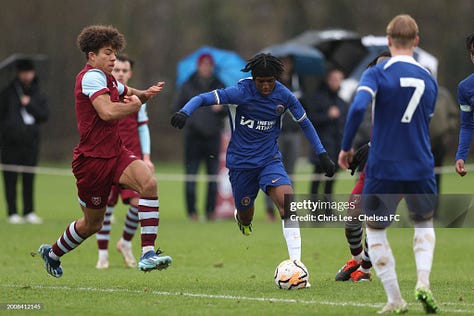

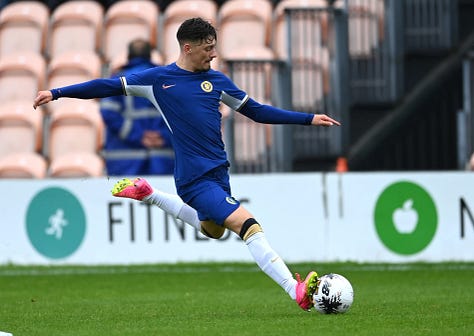
Chelsea signed Kiano Dyer and Leonardo Cardoso from West Brom at academy level, also poached Dylan Williams from Derby County to fill their left back squad slot.
Kellyman trained at Derby County then Aston Villa. These players are known.
Kellyman is rapid.
Focus
Rui Faria (long time methodologist and assistant to Mourinho, tasked to design the size / duration of training drills) coined the concept of “mental intensity”
Kellyman with a short decoy from the front, Watking reading the cue and adjusting on the hour clock.
Second ball, Jaden Philogene-Bidace scrapping to get something out of it (one of the many reasons why I like him and so should you).
Whilst his mate hassles, Kellyman “ball watches”. This isn’t nitpicking, that’s just the margins at the level.
Joelinton fron the same location, stayed switched on and gets nearer
Almiron gets the ball, Kellyman finds himself a couple of steps short to nick the ball
Almiron eventually gets away. One split second of attention can create the opportunity to win the ball, compete and make a foul, compete and make a tactical foul, or let the opponent go away.
If that play leads Douglas Luiz or Konza to take one for the team, pick up a booking and miss the game vs Arsenal that they ticked in their calendar (knowing that football, in panic mode, usually signs players who played well against them) ; the player who dodged the opportunity to make the foul will probably hear about it.
Players know two things: what they earn, and how many bookings they are on.
Consistency
Attackers need presence, and actions that keep defenders on toes.
Good players all have some sort of quality at this level.
The difference maker isn’t speed, but deceleration
The difference maker isn’t quality on the same standpoint, but volume
How long do you dwell between plays?
Kellyman’s drop and go is effective movement to dig out Schär
However on the play just after, as Carlos gets on the ball and Schär hasn’t quite recovered his position, Kellyman floats in between.
None of this is worrying in any shape of form. Simply that a senior game requires more, more often, with less time in between. No time to dwell on plays.
The rule of thumb is 5 changes of direction for getting one pass, for forwards.
Agüero was a master at it.
Successful people don’t try harder than the others, they try 5 minutes longer.
Creating space
Kellyman definitely has “a stride” that is scout-friendly and eye-catchy.
Glides over the pitch, and can create his own space
Bypassed,
decides to draw the double team away, and Metcalfe (6)
A change of direction and he can drop back in the space he vacated to show for the ball.
Creating space for one self requires awareness
Creating space for others requires selflessness and a degree of reading of the game.
Second balls
Kellyman looks keen to help out his midfielders, and grab second balls
Challenging the Newcastle midfielder, albeit could get the body / arm infront more efficiently.
You can work on that, but you can’t work on getting midfielders to be arsed to harvest a second ball. Mindset is fueling actions, one can’t engineer making people being arsed.
Box movement
In a not too dissimilar manner to Havertz (basically an all action rotation 8/9), but more second striker than pure 9, Kellyman likes to hang out around the penalty spot for cutbacks.
You can train a striker to go near post
But you also have to respect people’s intelligence
William Saliba or Ibrahima Konaté didn’t reach the top of the French talent pool (theres a bit of competition) by letting people go near post.
Can you improve Jackson / Kellyman in being Jhon Duran or Demba Ba?
If they don’t have it, they won’t have it.
At least not to the level to fool William Alain André Gabriel Saliba.
The man is litterally a one man back four. You shall not pass
He can, usually above 95% succcess.
stop shitposting Seb, stick to the agenda.
Heading
Opposed heading differs from unopposed heading.
Opposed requires leap, strength, timing and bravery
Unopposed is mostly about technique (and not be afraid of the ball)
These are one of the aspects Kellyman has to refine at the contact of stronger / taller players.
Easy to see Kellyman standing out, but Joelinton is a big boi and they’re basically all like that
I was in the tunnel for Germany - Italia in 2016.
Most relatable player was 1.82 tall Joshua Kimmich.
Kellyman reaches the ball nevertheless
Even ending up - somehow - in possession of the ball, there’s a fine like between outlandish self confidence and turning the game into a game of basketball.
Success rules, if you succeed, we can’t say you didn’t try
If you don’t, you must accept there’s situations that require recycling to go again.
Some perspectives of football require the guy who wins the ball back to dump it, as he’s regarded not having the composure or grasped the picture to make something out of it
There’s no point tele-guiding players with strict rules like that, rather educate into reading situations.
It ultimately boils down to this: how much effort was needed to win it back, did you find yourself trapped between three opponents? The level of composure you have (left) - can it really lead to more composure a moment later? Difficult to say.
However, Kellyman seems to have a good unopposed heading game (defender bumps into him, he’s not actively challenging for it)
Workrate
Kellyman’s closing down angle is good:
Make a U to protect the imaginary line between the goal and the goal
then close down in front
Sharp cutting movement, albeit a bit far from the base
Long leg? That’s Joelinton’s change.
See how Joelinton makes sure the ball is shifted to the farthest point to his opponent who can only clatter his knees to try to reach for it
On a repetition of actions, only modern training puts players in constant transitions / adaptations, reading situations, making quick decisions.
Talking “OOP” / “IP” makes it look like you’re playing scrabble with an Oompa Loompa.
Kellyman wins it back, immediately spins to run in the other direction in a motion that makes him recognizable
We note a right foot shot with the laces for a righty, which is good
Finishing
The chance Kellyman had, is reminiscent of the goal Havertz scored vs England.
A balanced effort, curling past the top corner
Kellyman has the “shift and shoot” with the poker game Cole Palmer likes.
Don’t listen to nerds, finishing skill is a thing, simply because it has a set of actionable criteria that usually bring success when met. That it’s too granular to notice in the data is just an invitation to use your eyes
I posted a couple of notes when people were laughing at “haha Palmer 200 minutes”
Yes, the guy can score and there’s enough criteria met, and a track record of him hitting corners.


Kellyman might not be quite there yet, but like most things: intentions are noticeable
Resonating with a point mentioned above, top level football works at 100mph
Lessons from Jermaine Defoe would be to always be ready to receive it (on crosses especially, air-shooting finishes).
Bailey is 1v1, and Kellyman sort of freezes
Best way to help a team mate is to get away from him, so that you can join and provide support with a clear movement towards him
Ball tumbles inside his lap, and like most good “ballers”, Kellyman masters the trick to handle any type of pass by having it bounce between the legs.
That’s semi random, but arched legs, agility and flexible ankle create a platform for “rebounds” that keep the ball in “control” (and not roll past, or hit the backheel).*
Ballers can’t explain it, but they “bounce” the ball in their lap all the time.
Kellyman triggers a shot with the laces fairly quickly, decides to go near post (is blocked) albeit his motion could’ve deceived defenders into shooting far corner.
Tony Pulis’ Stoke or Guardiola’s City? That’s right. Defenders defend, block shots.
They don’t need to pass, John Stones plays in midfield for that in the Glen Whelan role.
When 1v1, there’s always a step between Academy football and first team football where goalkeepers are obviously better.
Aiming for the area betwee the arm and the leg is usually a good recipe for success
From Omari Kellyman’s own social media reel
One of my favourite striker tricks: make the defender dance with a couple of extra steps so that he opens the leg and you shoot in between:
More on the subject of “turn of pace”
Bukayo Saka is also diabolically good at chosing the right moment to knock past players and change gear, after his reception.
Kellyman likes a heavy shot with the laces which is elegant and fluid, but might get blocked more often.
Ollie Watkins’ small touches and hammer shot triggered as wish is probably more brutal, but leaves less cues for defenders to guess
Kellyman’s footwork is quality
set the right leg, to shift it with the left
hopping to bring the right leg closer
So that it lands next to the ball toes pointed to the target, arms for balance (and repeatable motion)
To note; this is not exactly a curler kissing the post, more an angry Cole Palmer effort.
Kellyman wants to hit the back of the net, and goes through the ball
A composed finish, from the penalty spot he likes to hang around on crosses.
Players aren’t “positions”, but they have preferential areas.
A guy who goes near post is a 9.
A guy who goes 2nd post or cutback naturally, isn’t a 9.
No matter how many minutes they get in each position on OPTA.
Kellyman would be used best behind a wall pass 9. Like Havertz, Palmer.
There’s no general rule against square carries and shots at an angle. Lampard or Harry Kane would be very good at it over the years
Kane’s balance (hit with power, shoulders over the ball) would be reinforced by his planted leg not mvojg (with toes frankly pointed towards goal).
Kellyman gets a corner, and players who can shoot at an angle are extremely valuable
Mbappé developped a finish to drive it low near post (surprisingly, mostly in his Pochettino season).
My opinion
No need to dwell forever on the club’s policy as a whole. Signing superstars, or signing young players is what it is. The problem is clogging the wagebill with players that are neither. Money isn’t extensible, and it’s all about cutting off good but not vital body parts (Maatsen) when various type of financial deadlines appear on the horizon.
Kellyman is an attacker with promise, who stands out from a regular talent pool: he’s taller, quicker, left footed, agile, has good ideas and excellent mastery in small space. That in itself warrants a spot in an Elite squad
We can imagine that his game will improve, hardened with more challenges from senior players, and feedback from opportunities he might be given. His attitude is positive on the pitch, and seems to have grasped feedback (closing down angles, ball mastery to receive…) suggesting that he can take more feedback going forward.
Then, when it comes to “making it”, a Carney Chuwuemeka or Cole Palmer have some world class traits that make them relevant options to impact games at first team level. Palmer doesn’t need “tactical structure” to look good, just did the talking on the pitch (as opposed to snide agent briefs to influencers to undermine organisations).
Or Tuchel selling every striker to warrant the vanity project starting at 9 until the bloke next door tried the same (but now wants Sesko or Gyökeres - all part of the same plan. Some are just allowed to fail for longer than others, but they always come down to what works. See Chelsea and their mock NBA draft this summer).
Kellyman isn’t there yet, he will be a live spark in a PL game and will have his moments. But is definitely closer to a Deivid Washington than a Cole Palmer.
The question about the pathway is fundamental. You can “moneyball” and replace skillsets that might be of the level in a few years, but you need to adress the question as to where these players will refine it.
With loan spot already squandered on the likes of Kepa, Lukaku, that argentine CB with 200 minutes. Chelsea will probably have to take losses (they’re unwilling to eat up Malang Sarr’s contract) or play a front 6 of Burstow, Datro, Washington, Richards, Morgan, McNeilly and Stutter in PL2.
Can Kellyman play second striker in PL ? Definitely, on the odd occasion.
As a backup option like Duran would have been for specific match-ups.Hard to see Jackson getting yanked for Kellyman when the team’s trailing.
As for Kellyman, a League One loan would probably benefit him, like the livewire Abu Kamara at Portsmouth. More than Sam Edozie, entertaining and lanky wide player, but restricted to the bench watching Stuart Armstrong in the Kieran Dewsbury-Hall role at Southampton when Saints Got Marched On one time too many. Losing 9-0 in a week to Sunderland and Leicester in September with half of Manchester City B on the pitch (Shea Charles at CB, Edozie, Bazunu in goal and Taylor Harwood Bellis) who barely sniffed the pitch since.
As a backup for Chelsea, Kellyman’s probably not gonna see a lot of meaningful minutes.
In any “kindergarten” project, Chelsea would need Ziyech or Azpilicueta on the bench. Not players in dire need of developmental minutes, that ought to be farmed out on loan, domestically.
Ultimately, you avoid injuries by training players properly: that’s what Pochettino did and the players under risk (38 year old Silva, Gallagher, Caicedo with no pre-season, Disasi, Palmer for his breakout season) never picked an injury.
But you also avoid injuries with compelling rotation options off the bench, Ancelotti was unimpressed by Bruma, Van Aanholt etc… in 2010-11 and would rather play Paulo Ferreira at CB (0-3 to Welbeck’s Sunderland), and when he gave a debut to Bruma, he got poster dunked on by Emile Heskey for 90’ (3-3).






